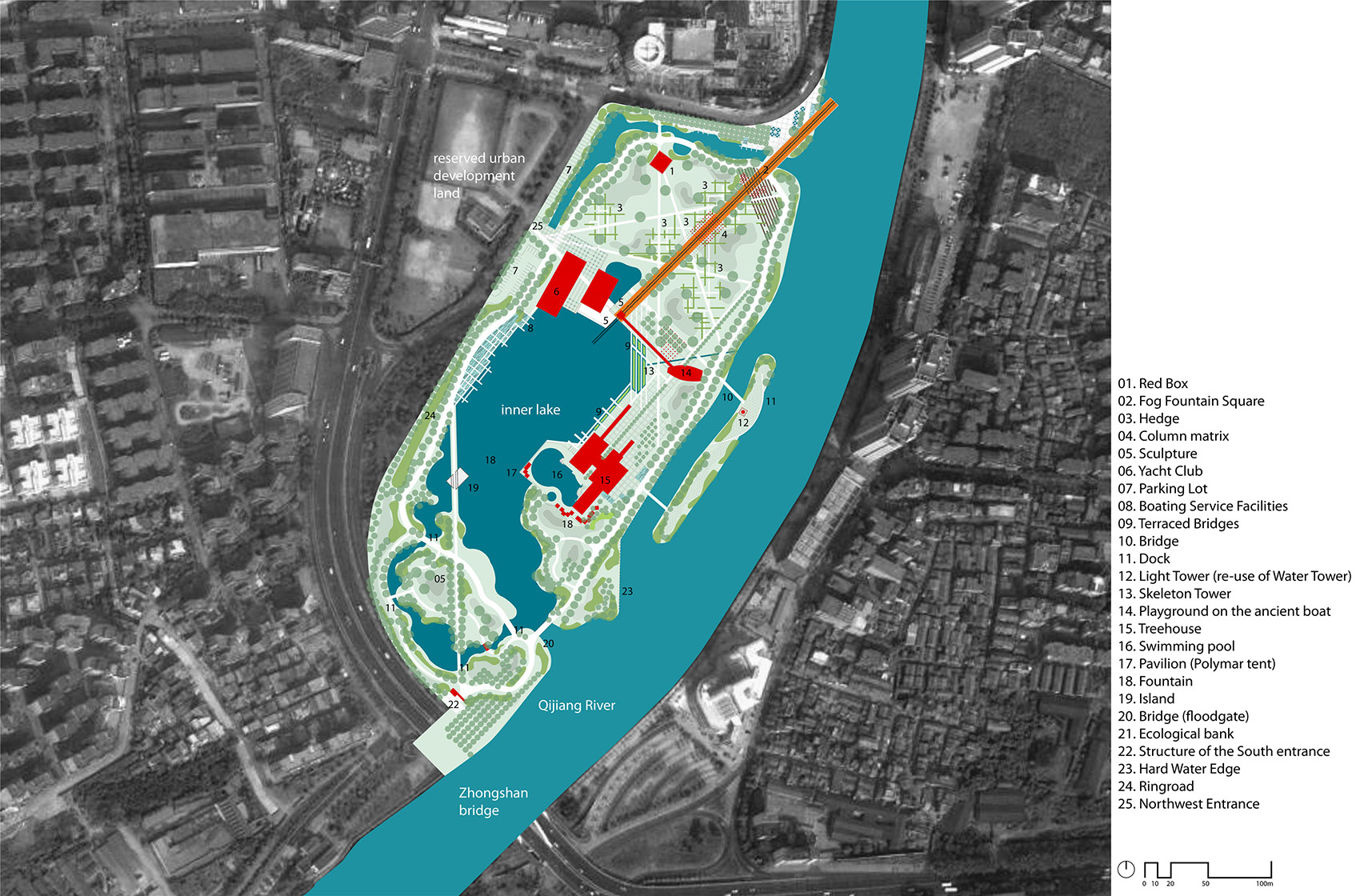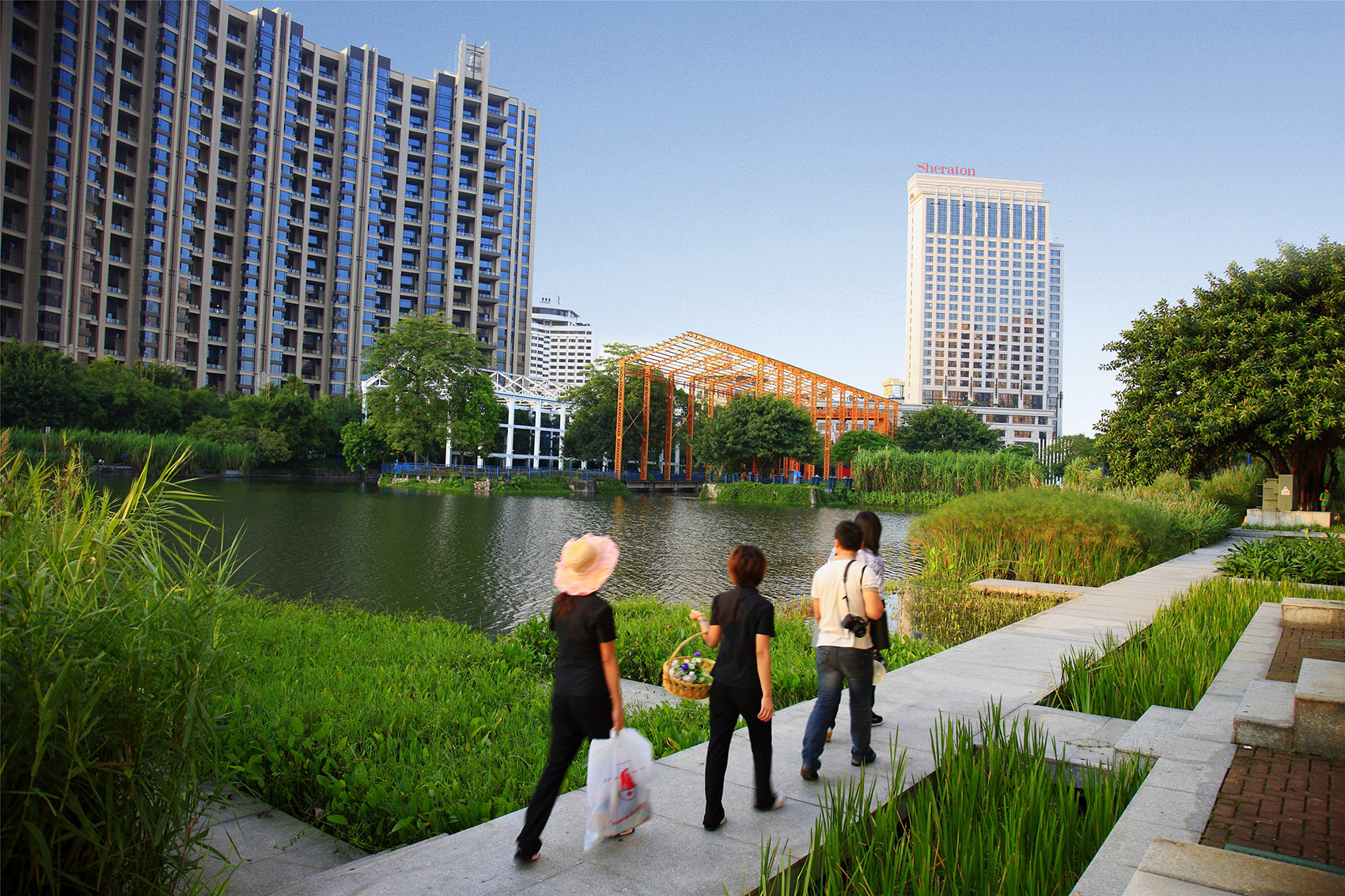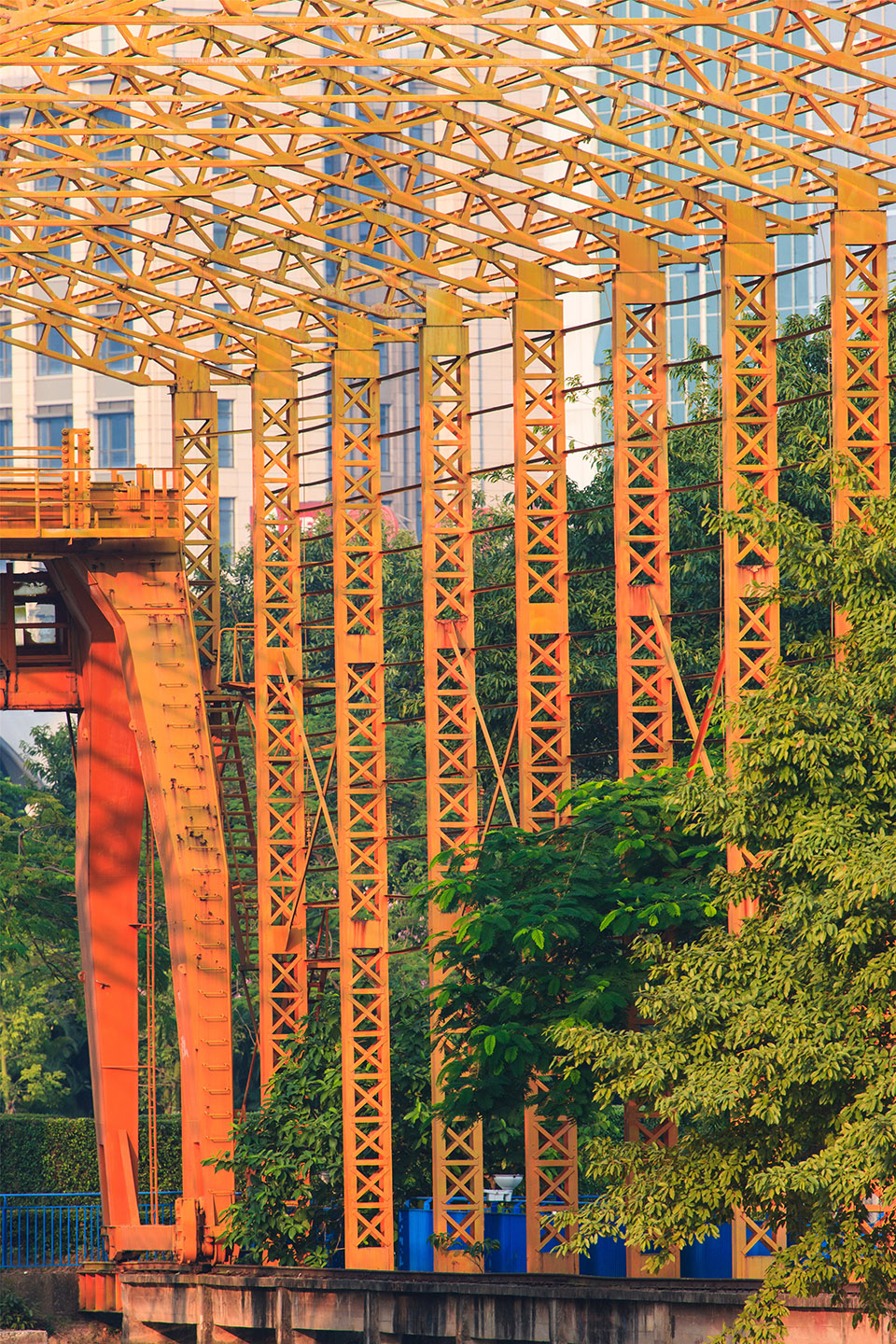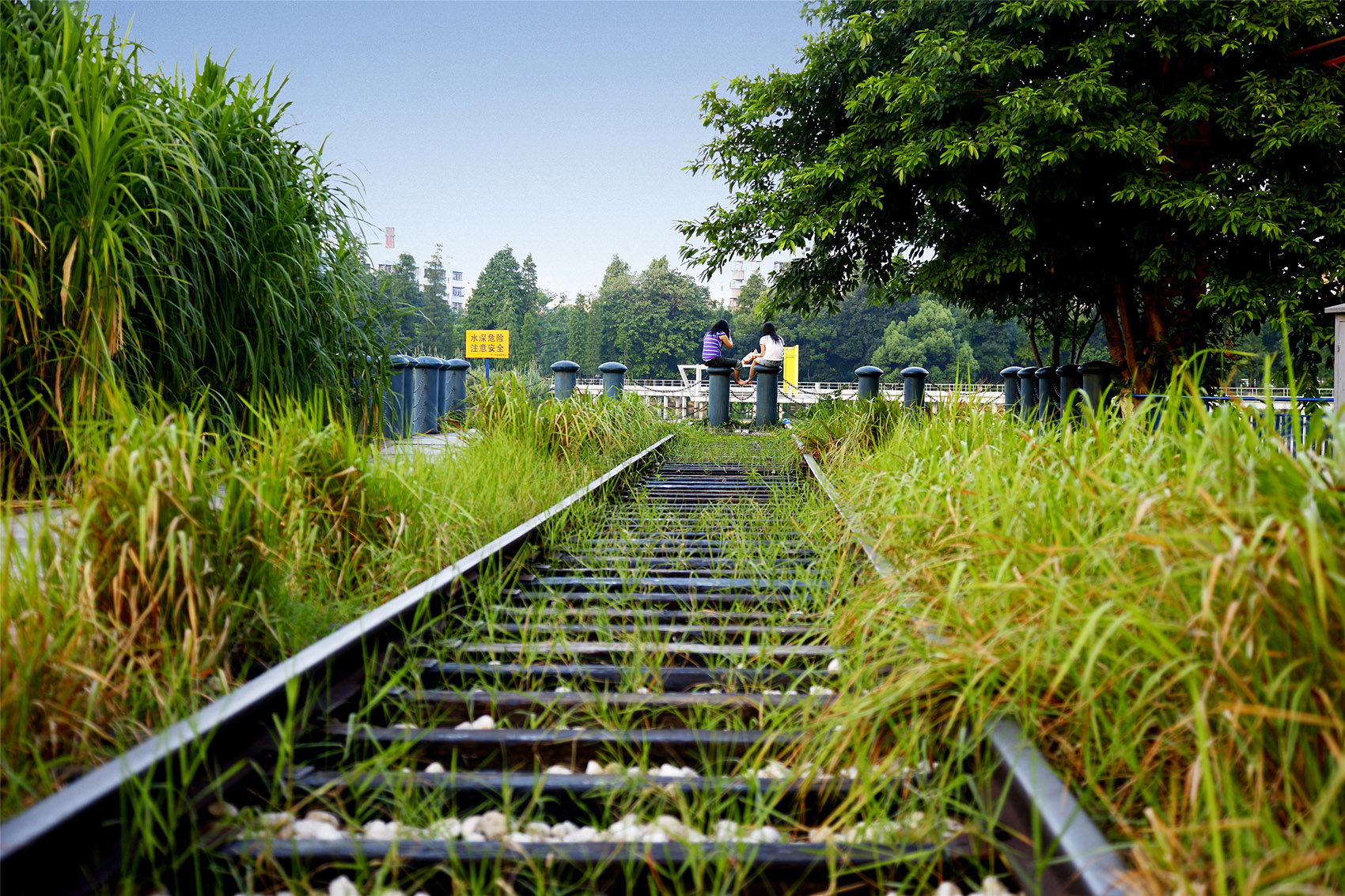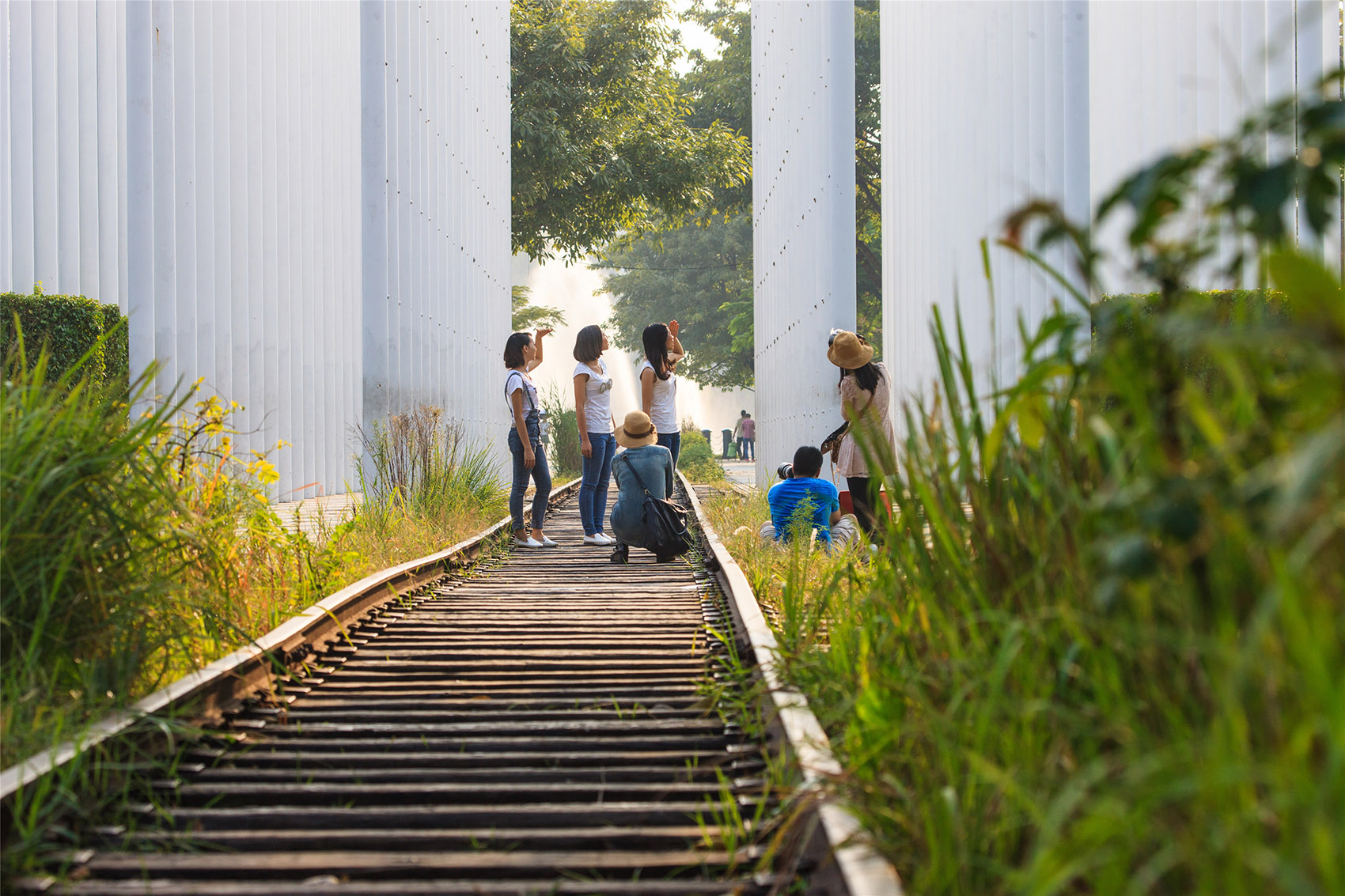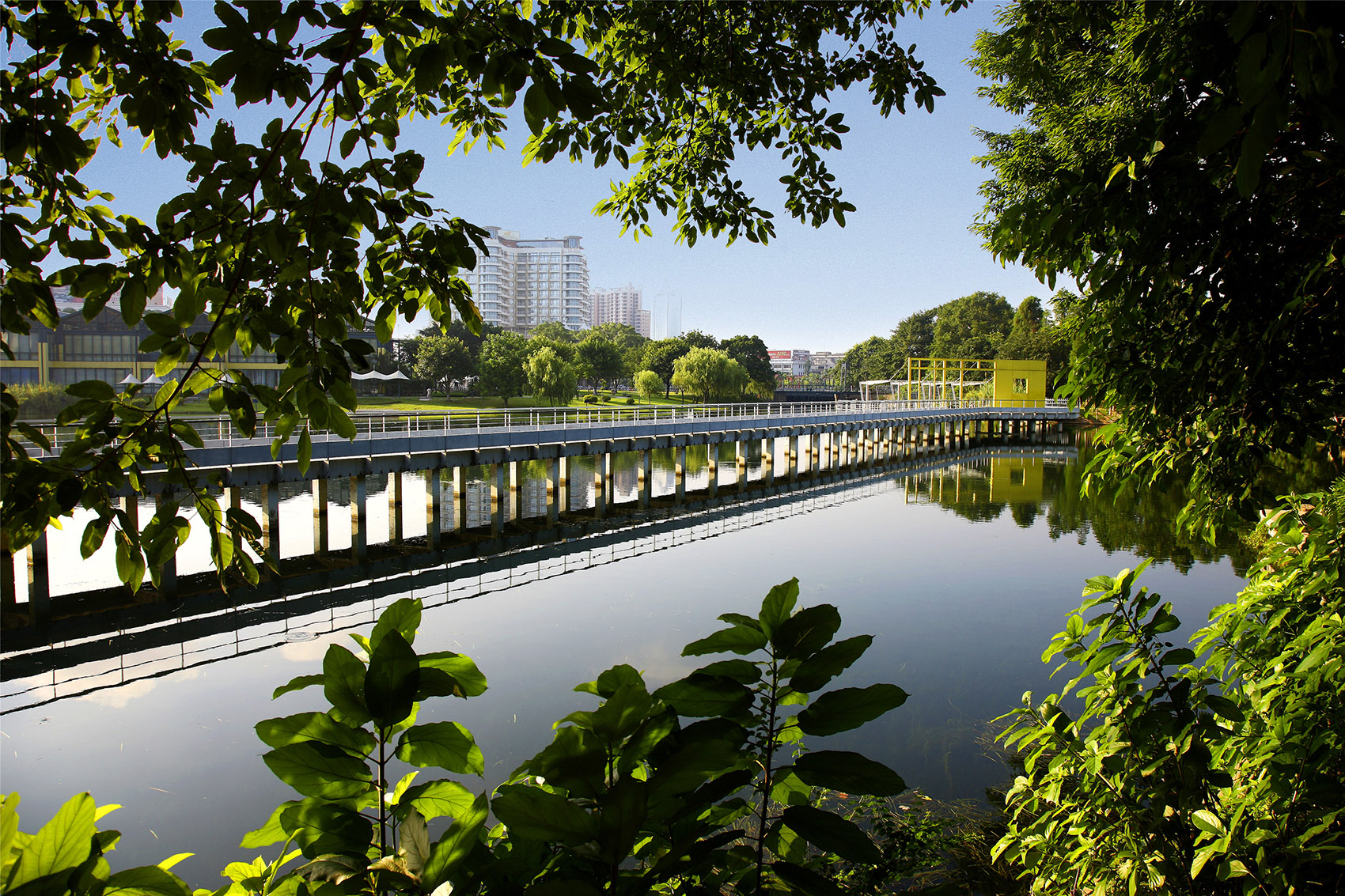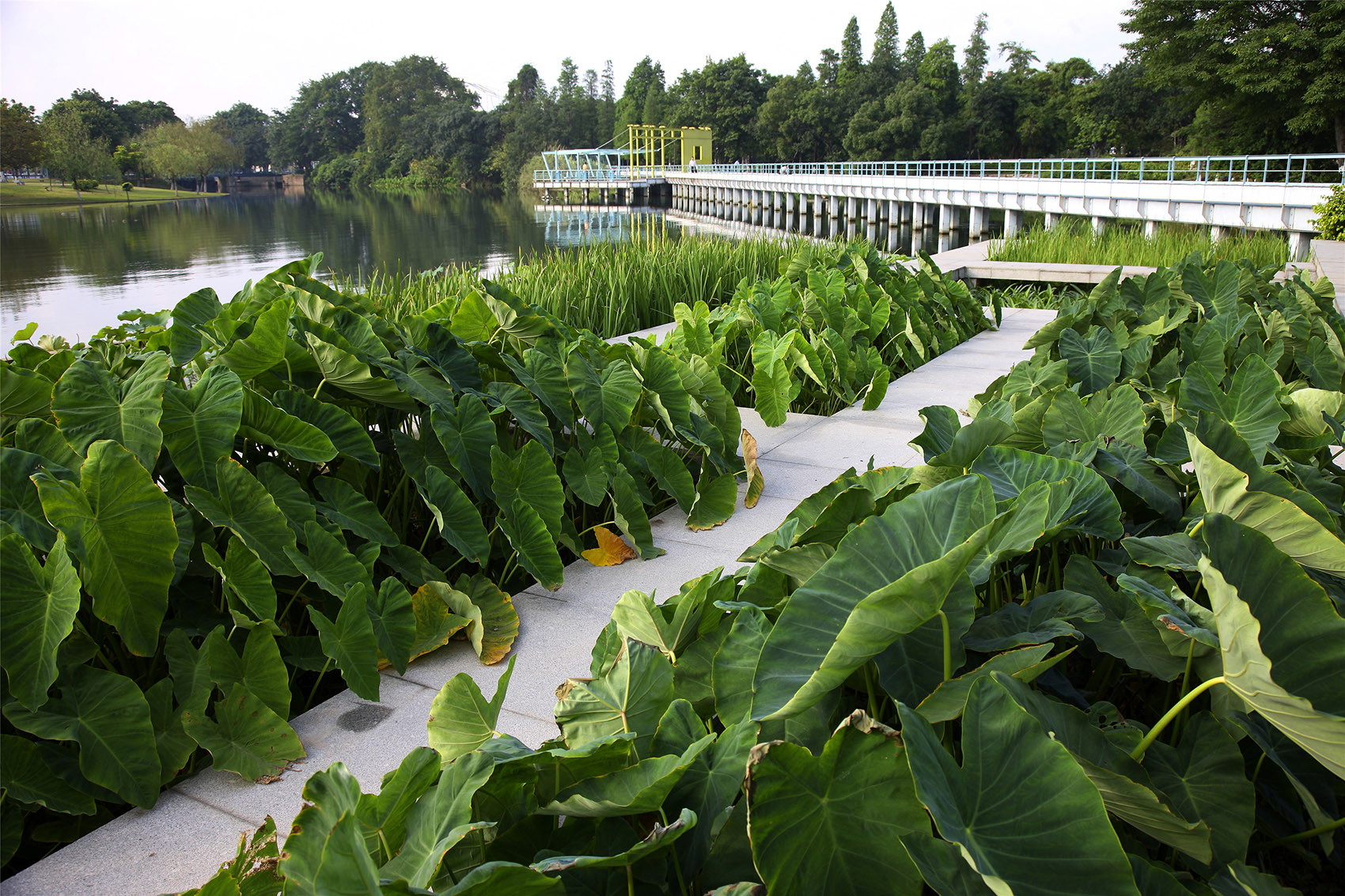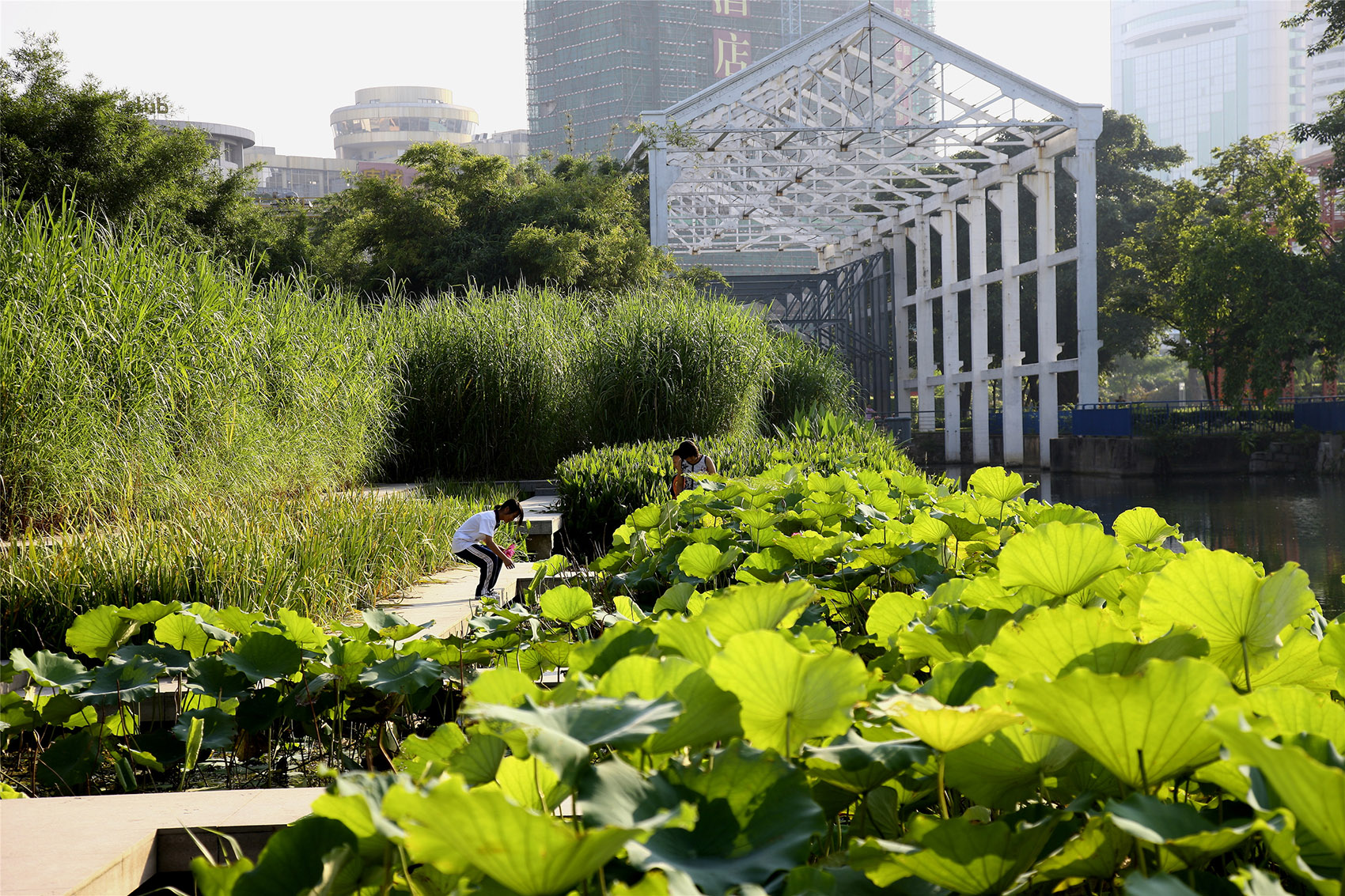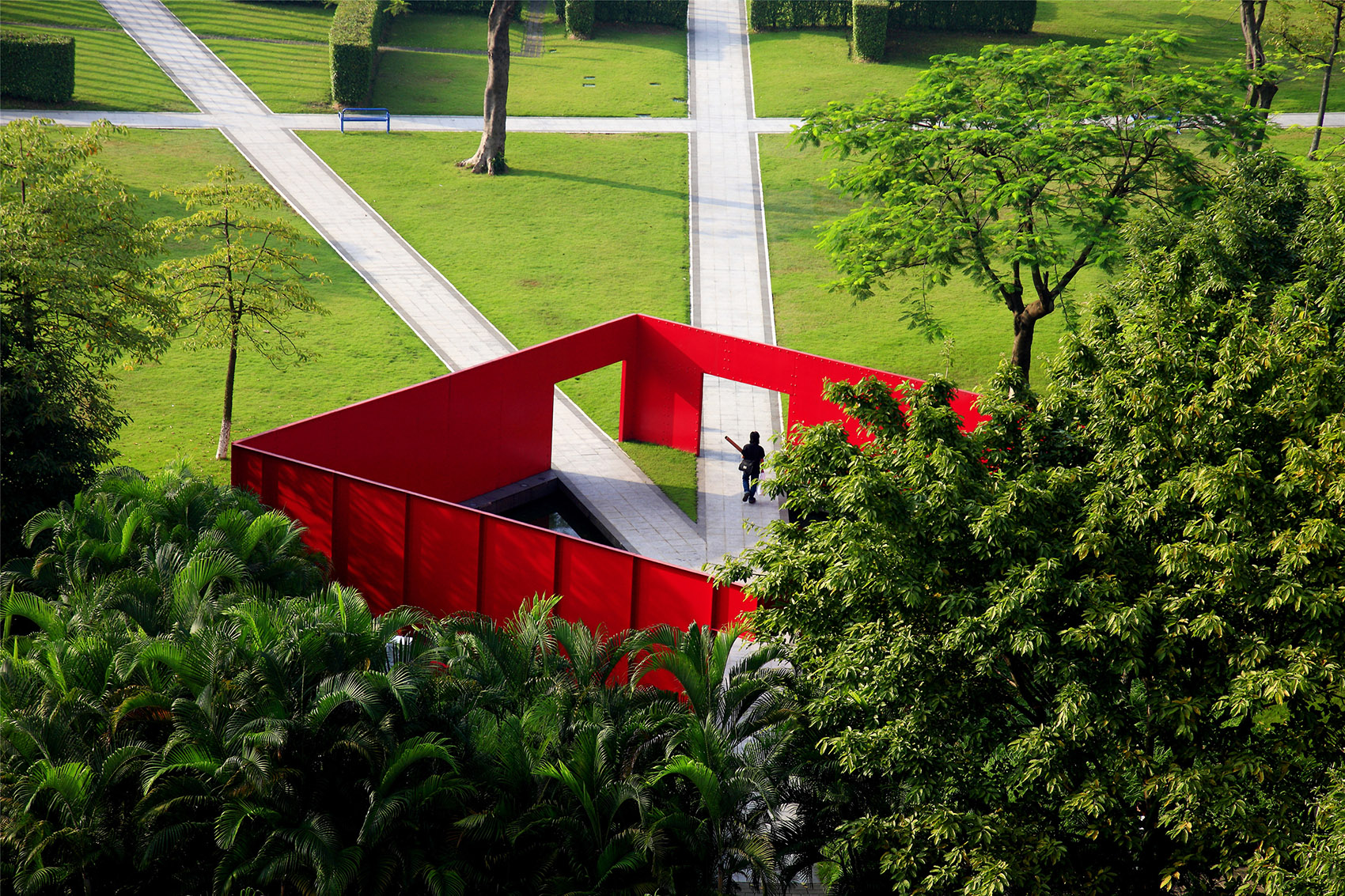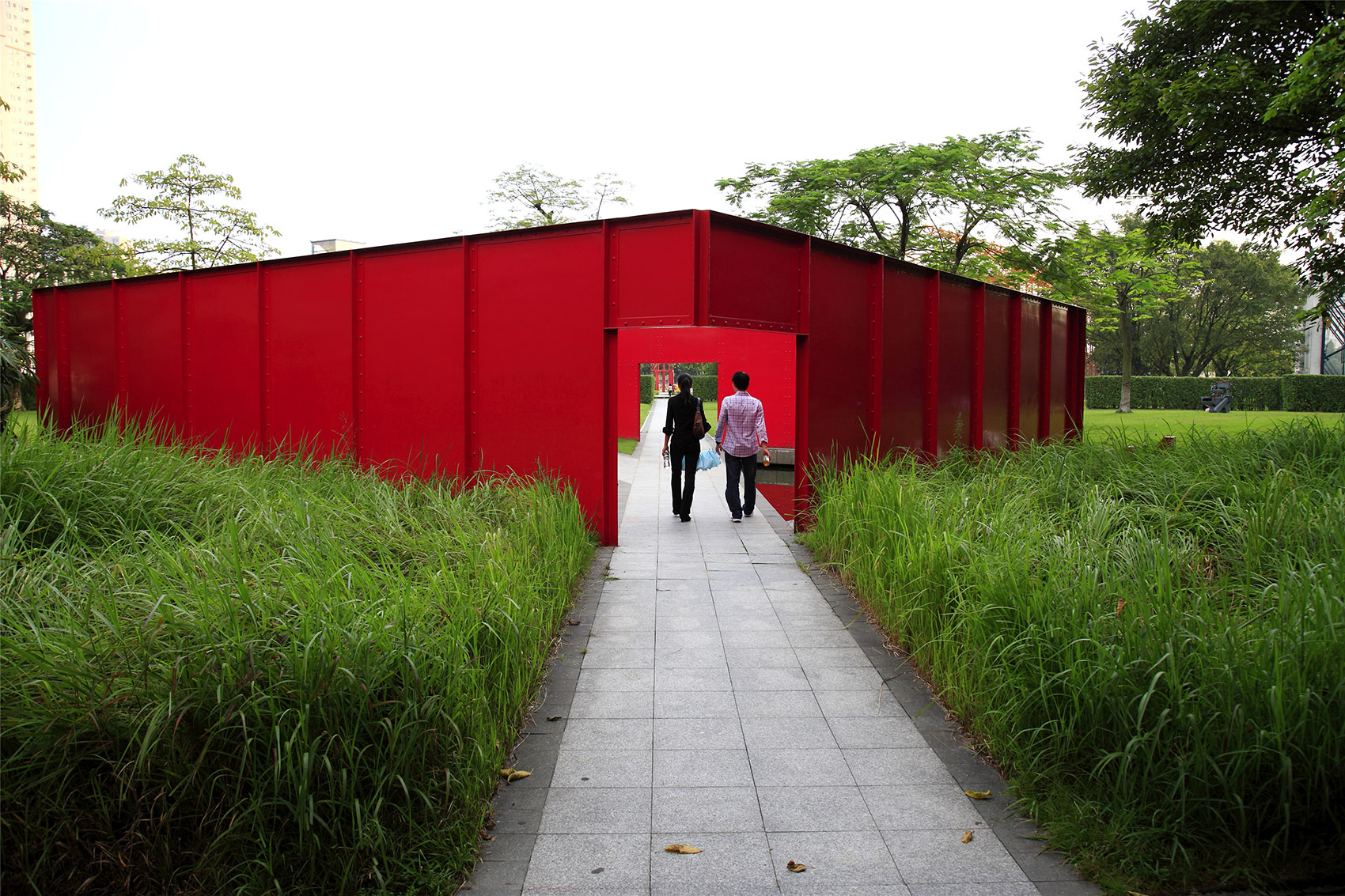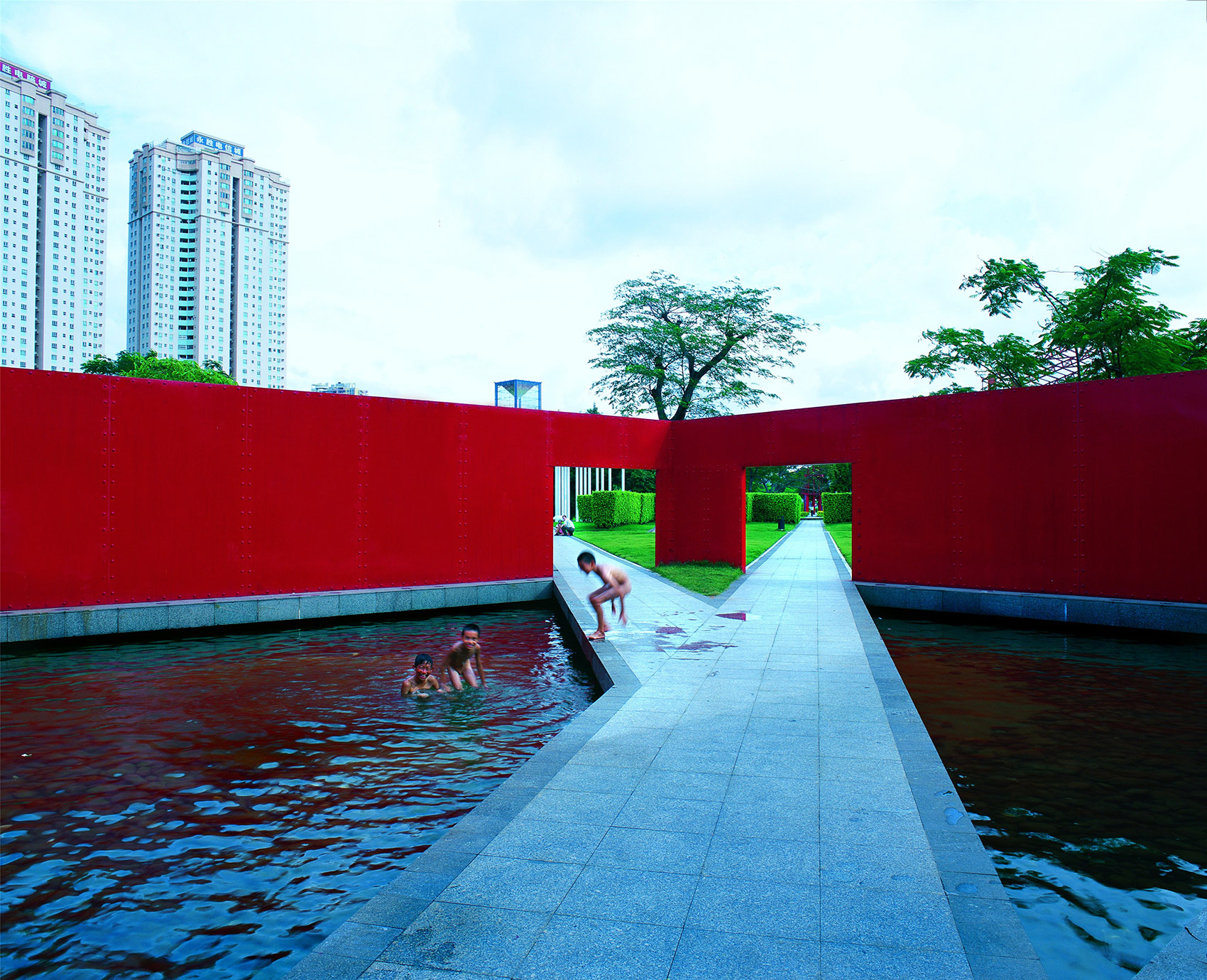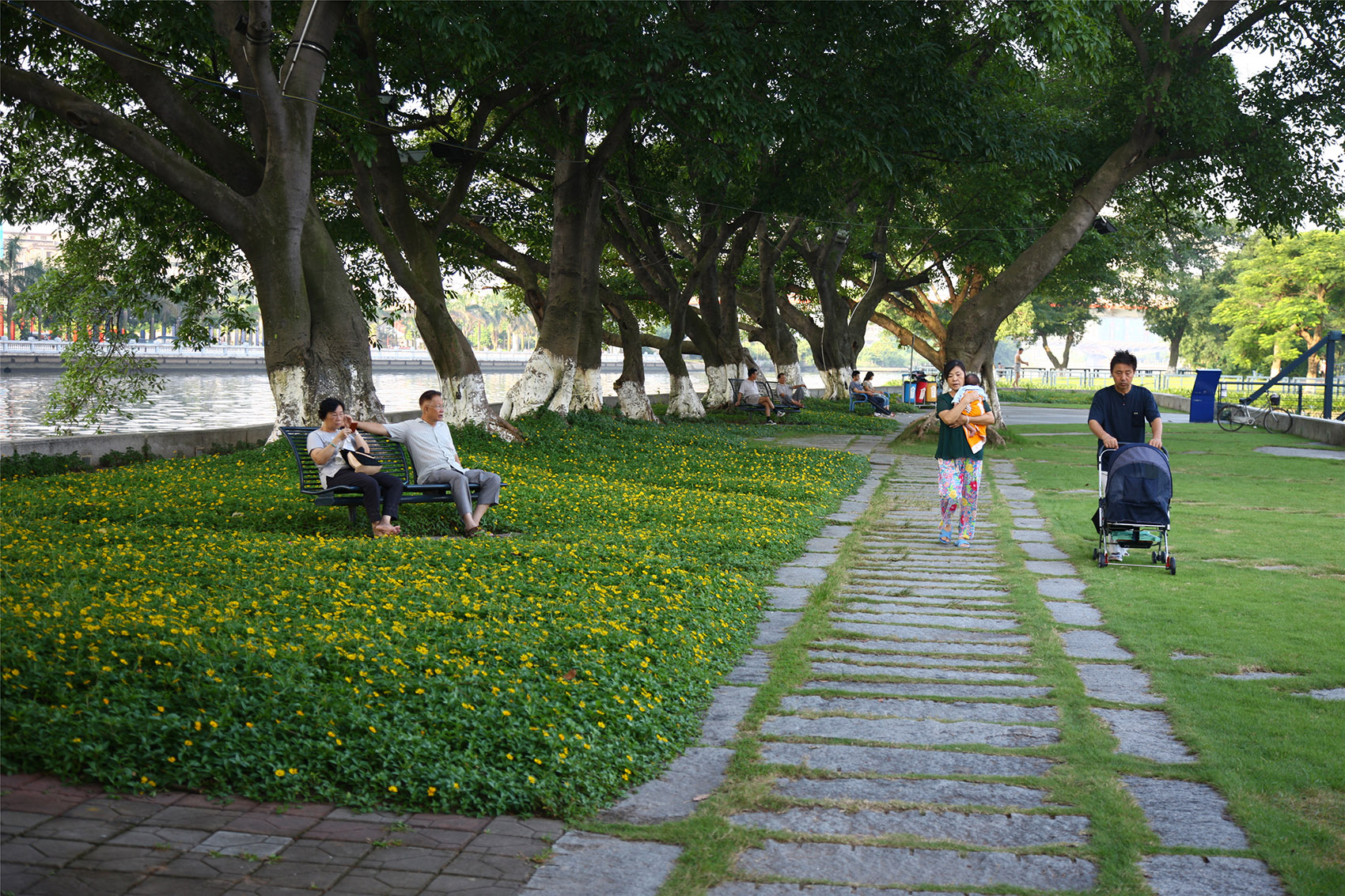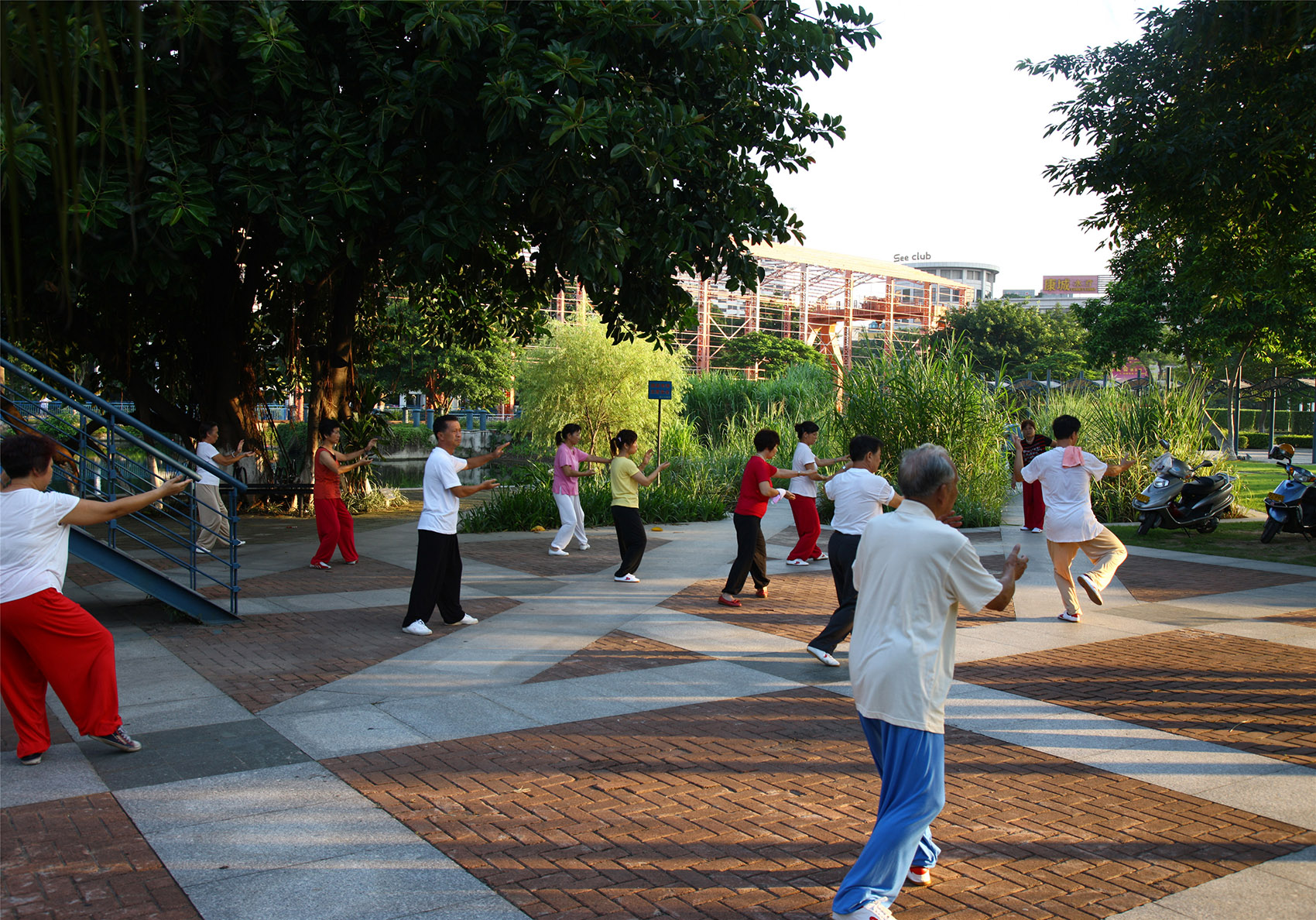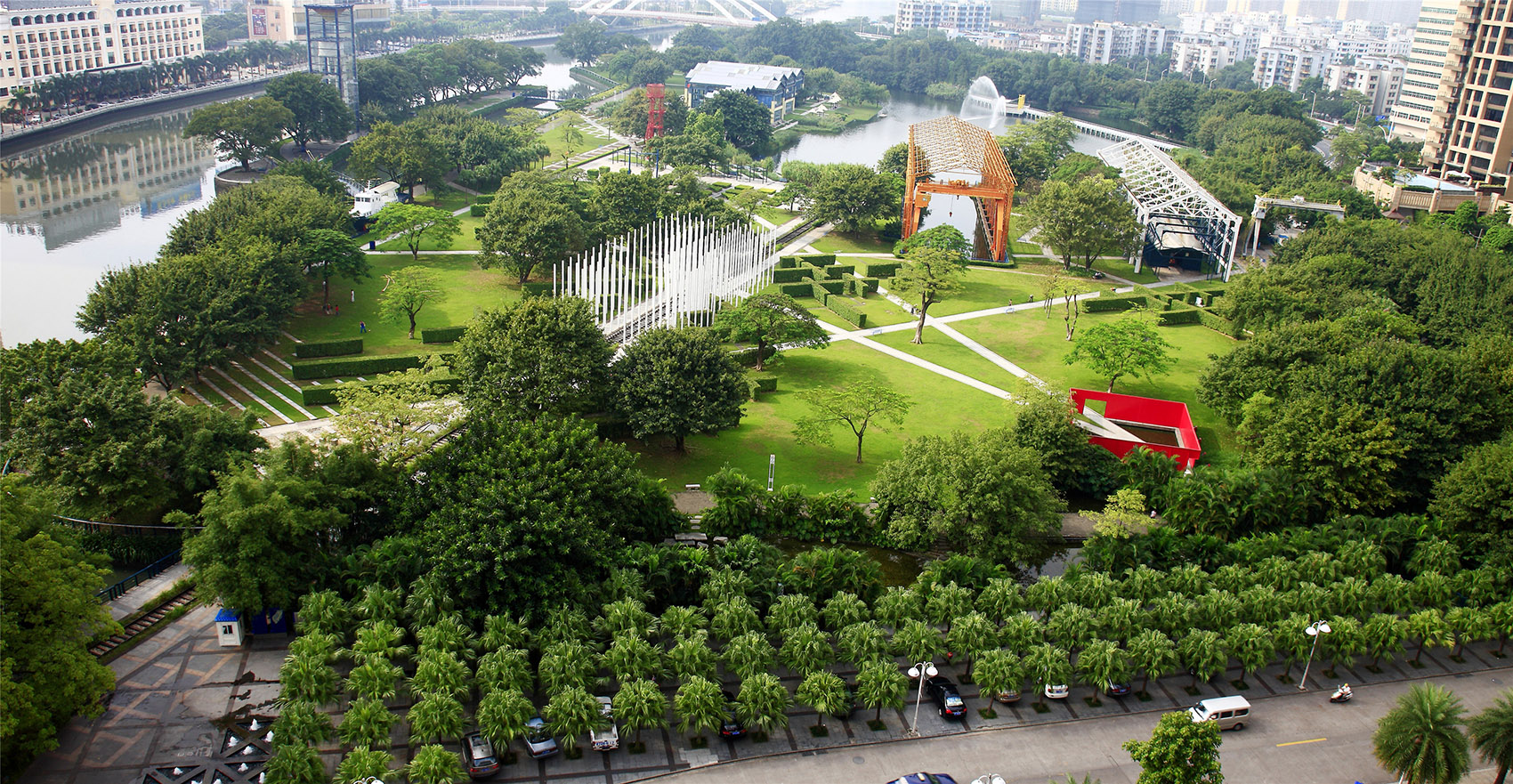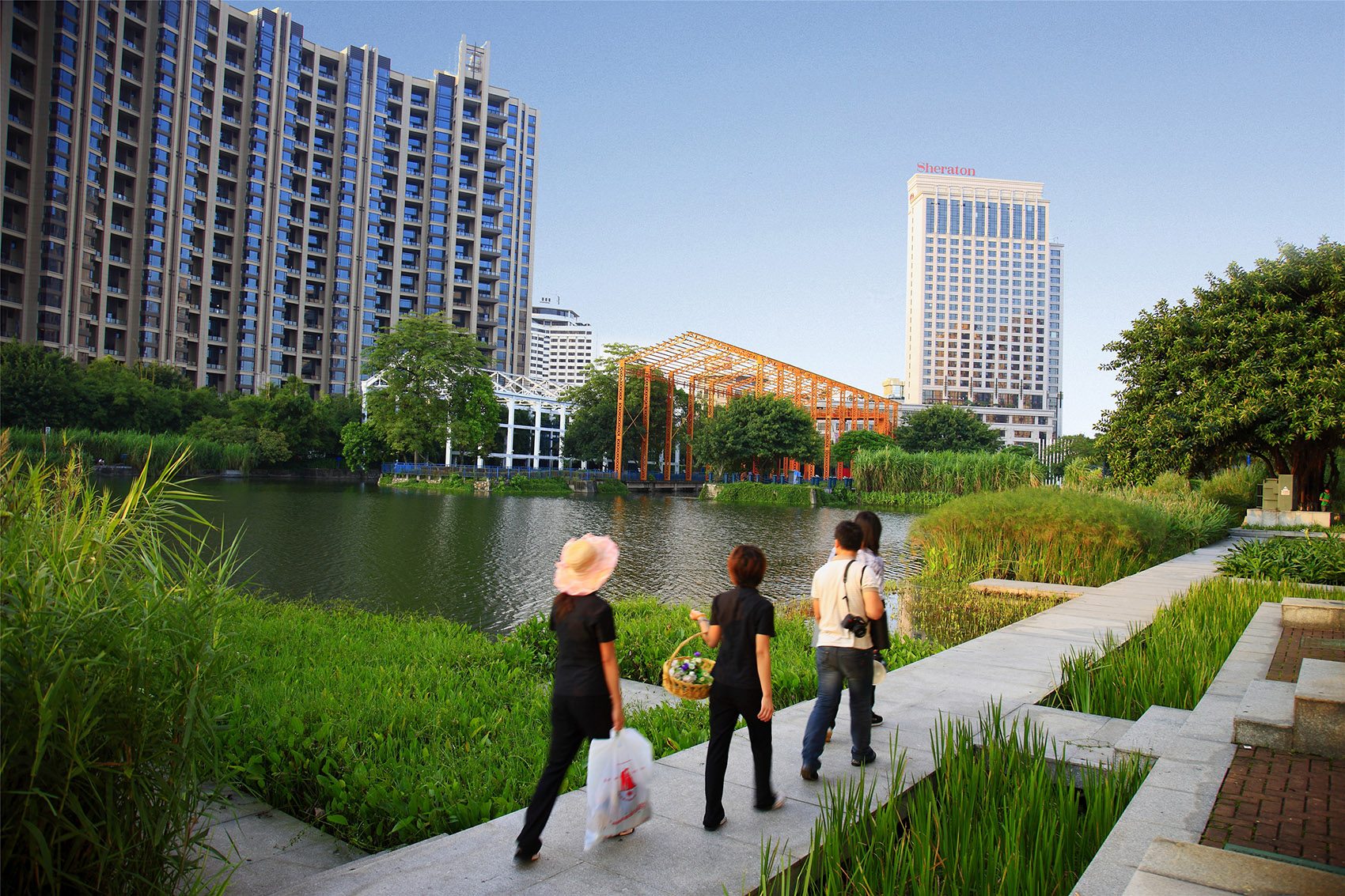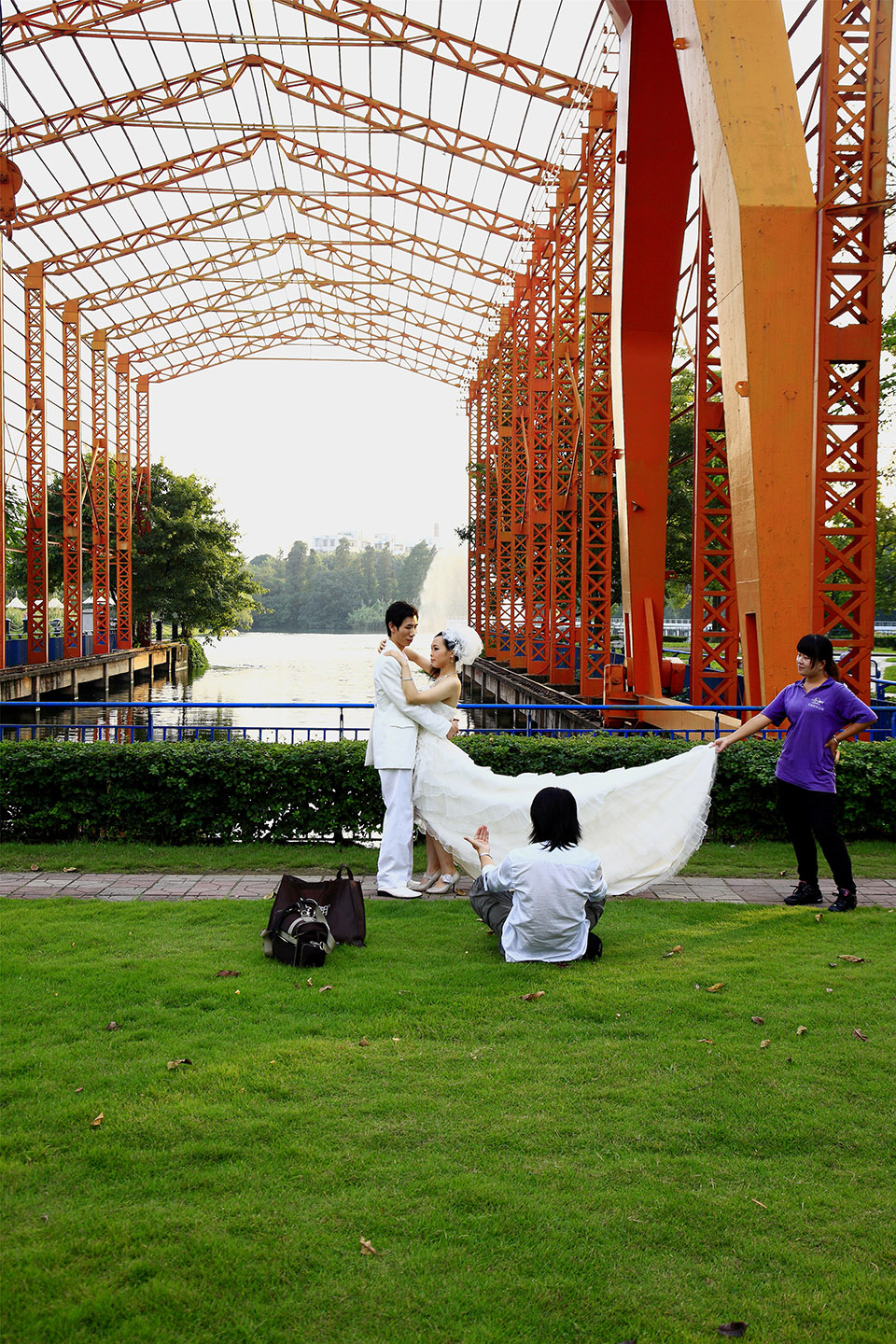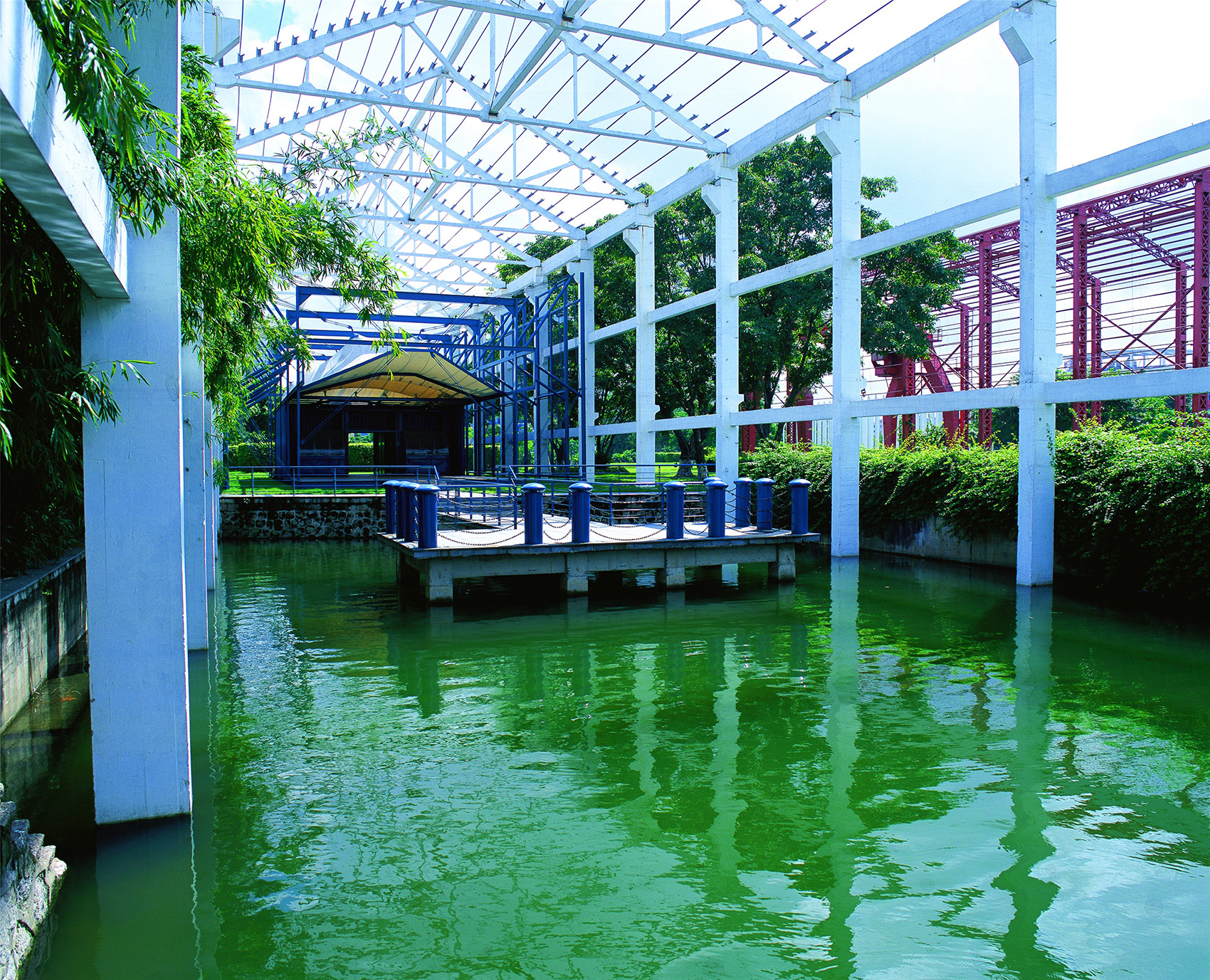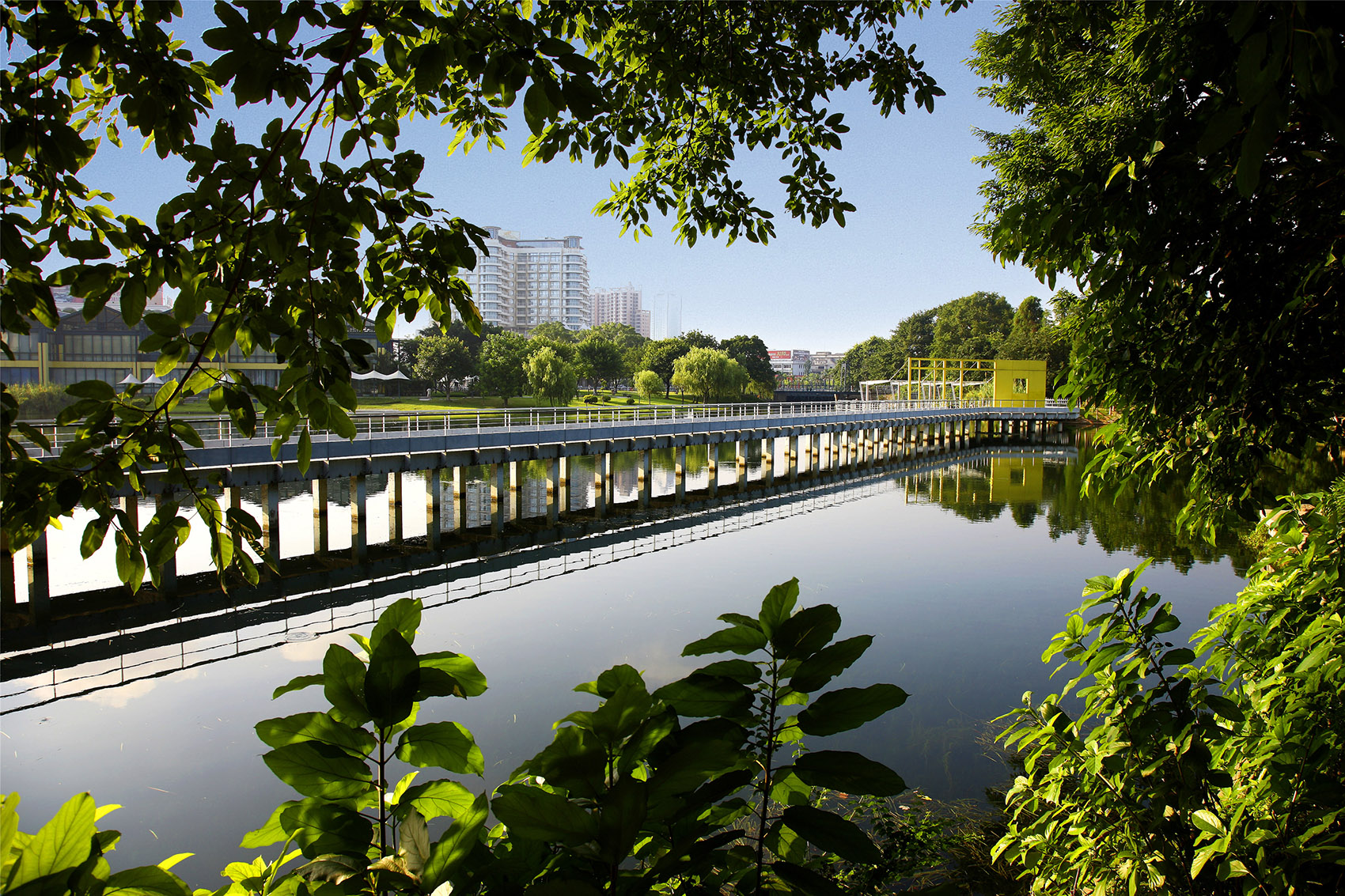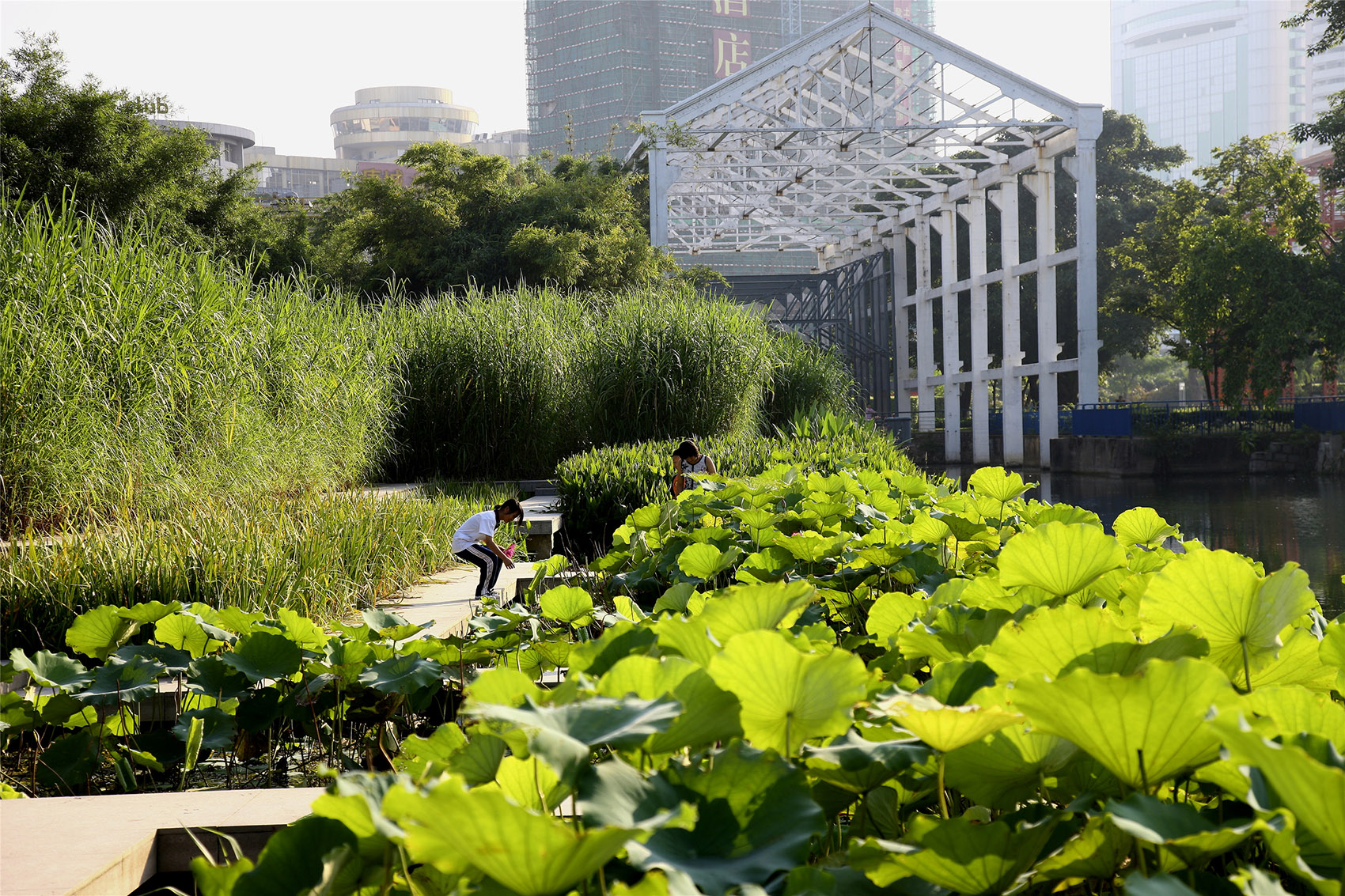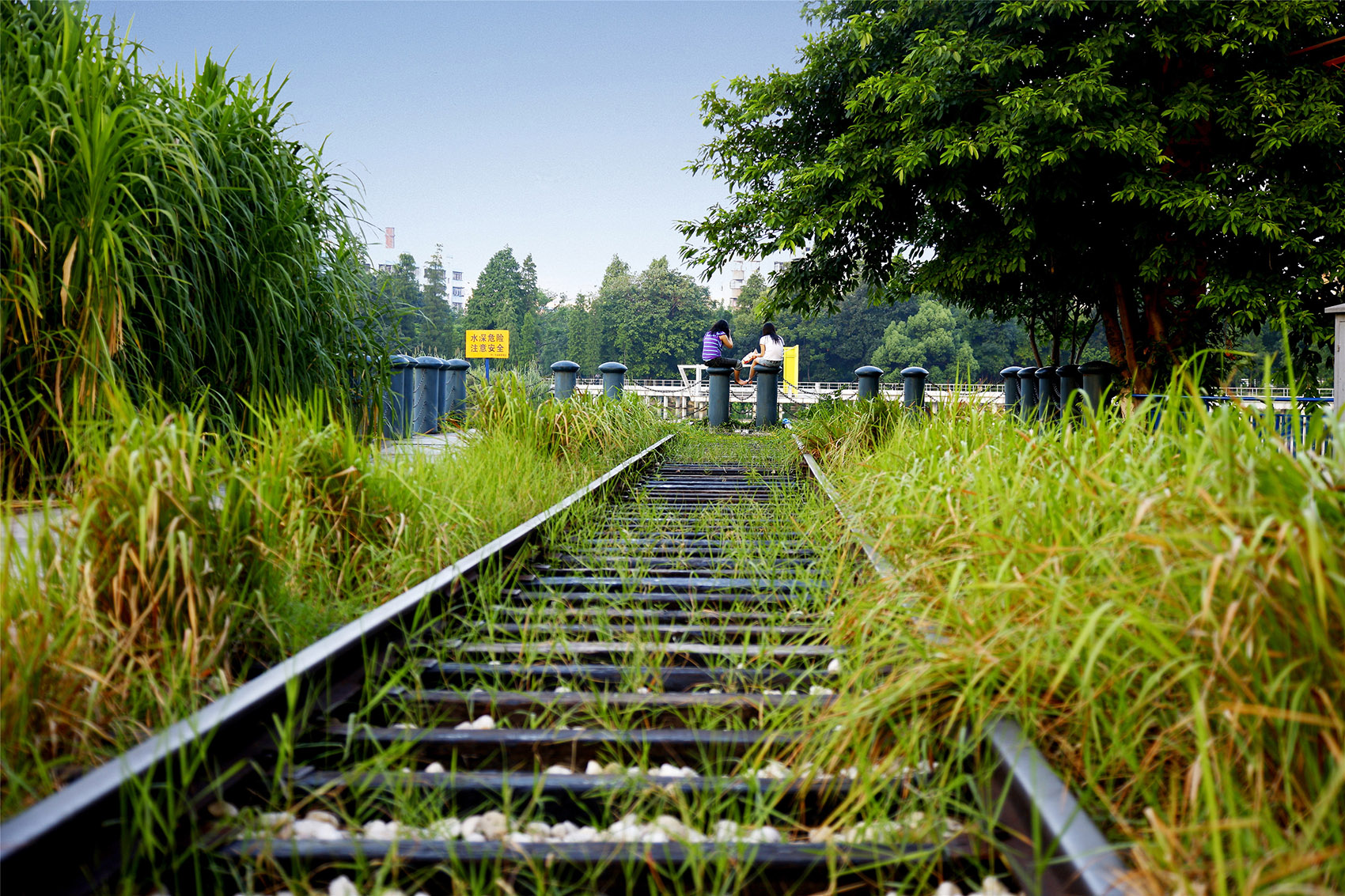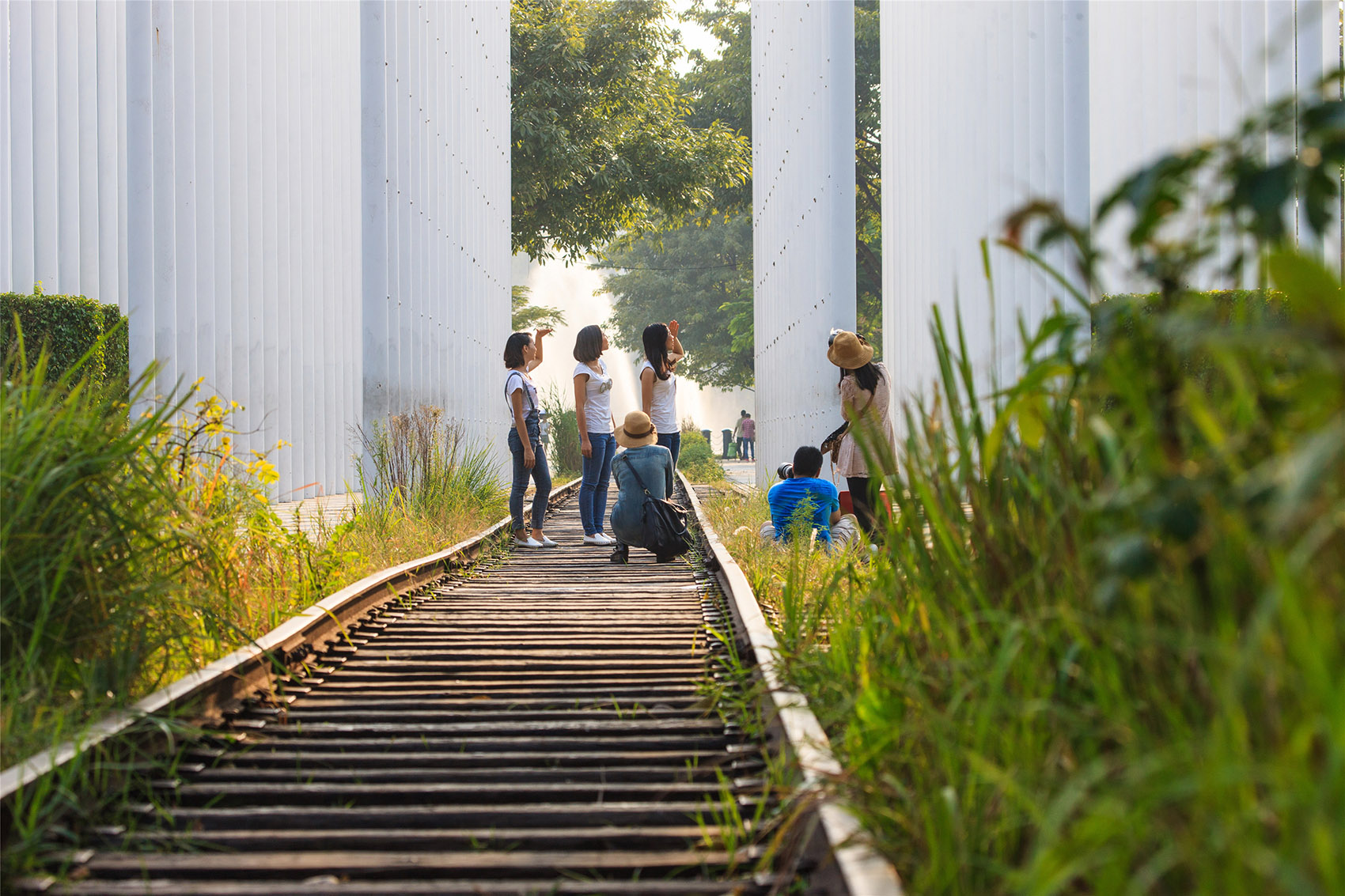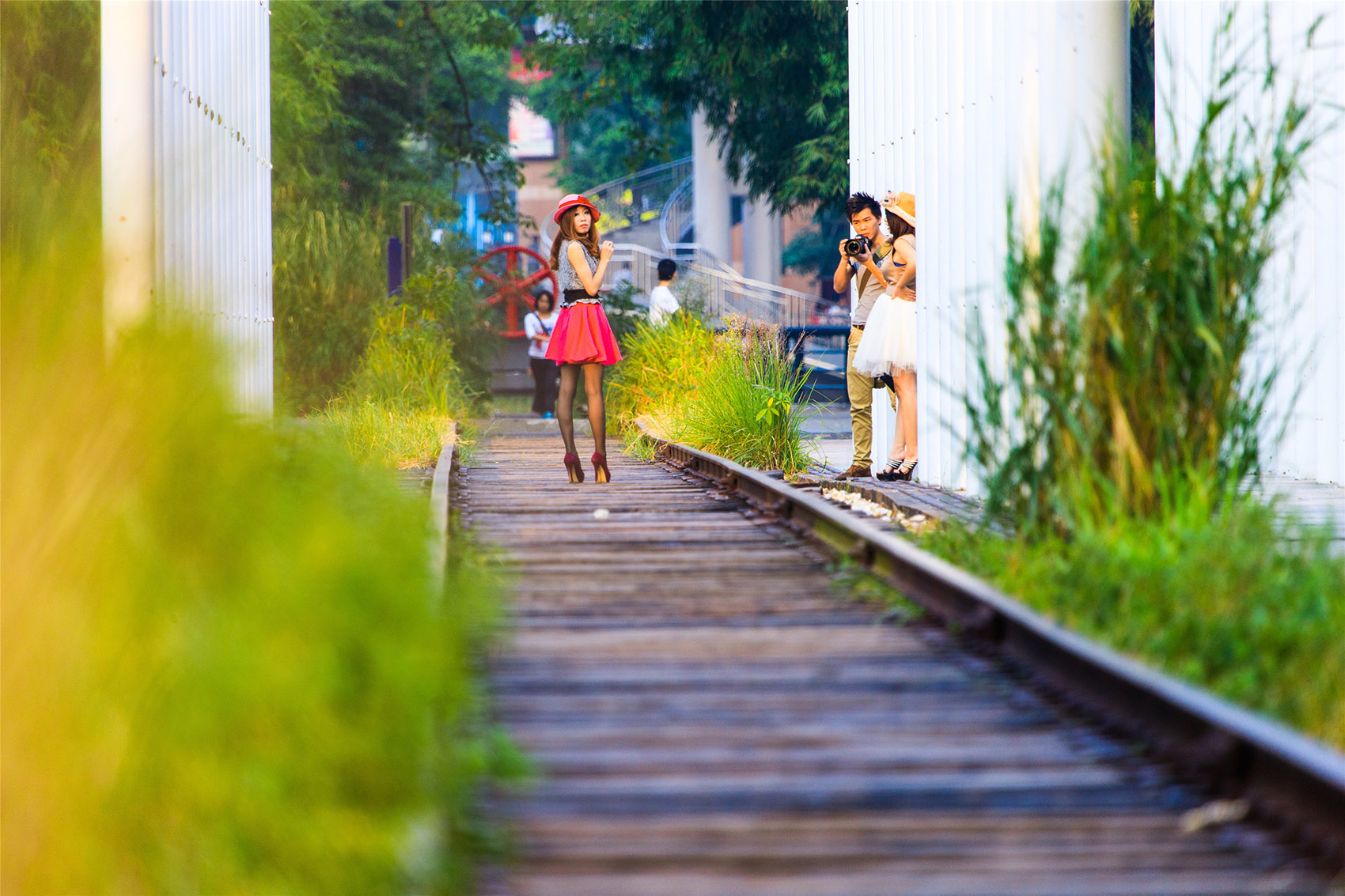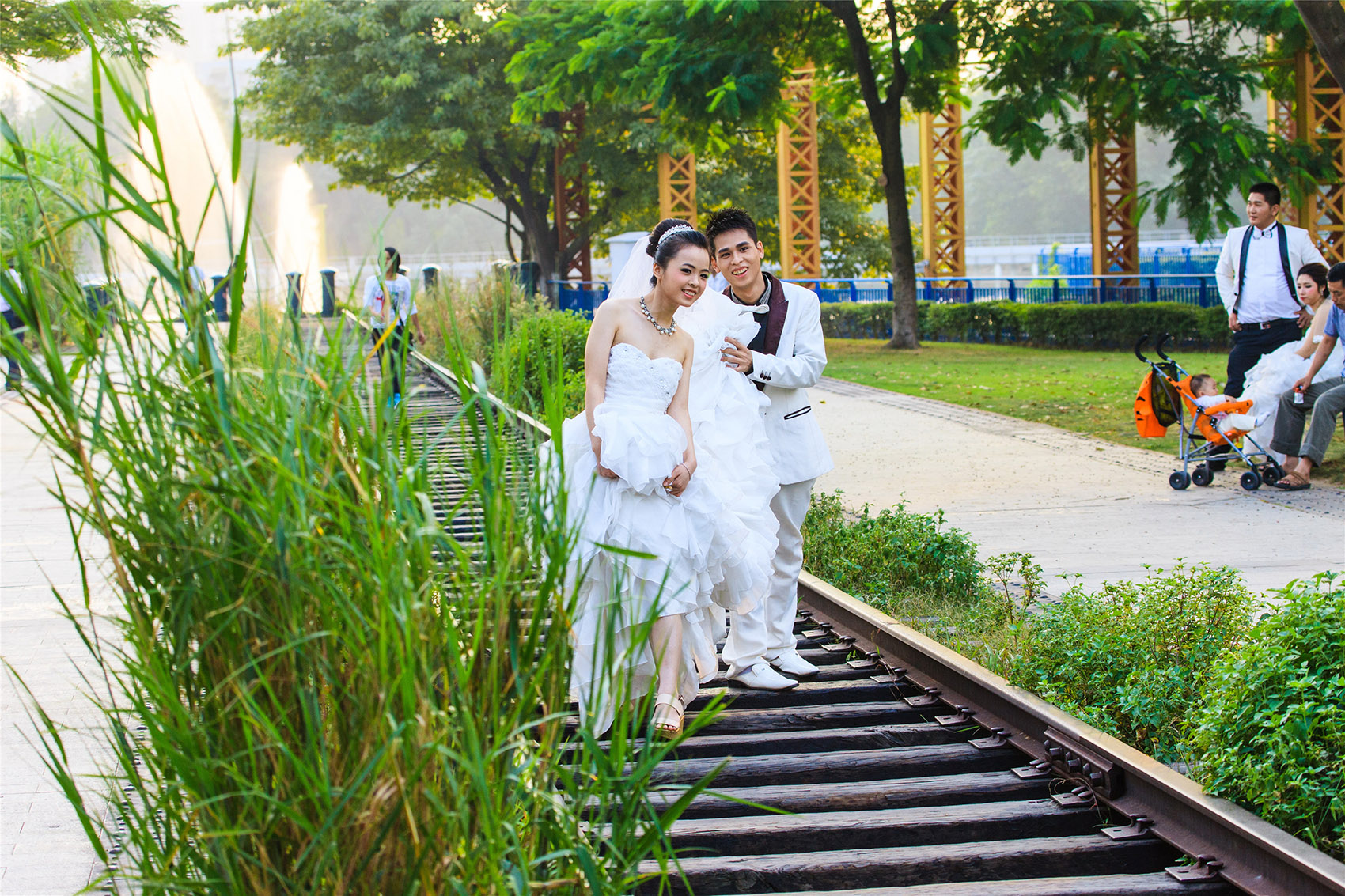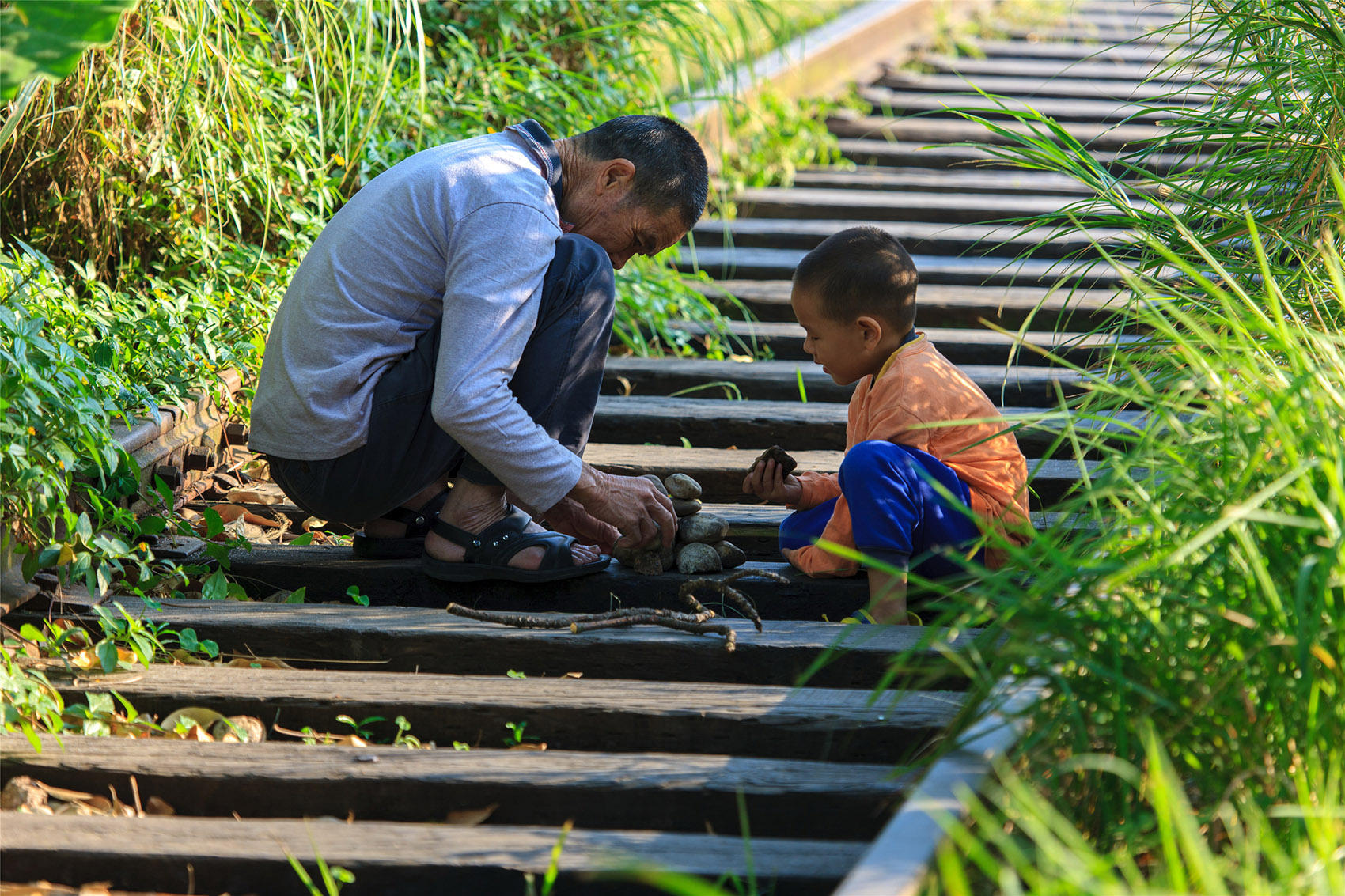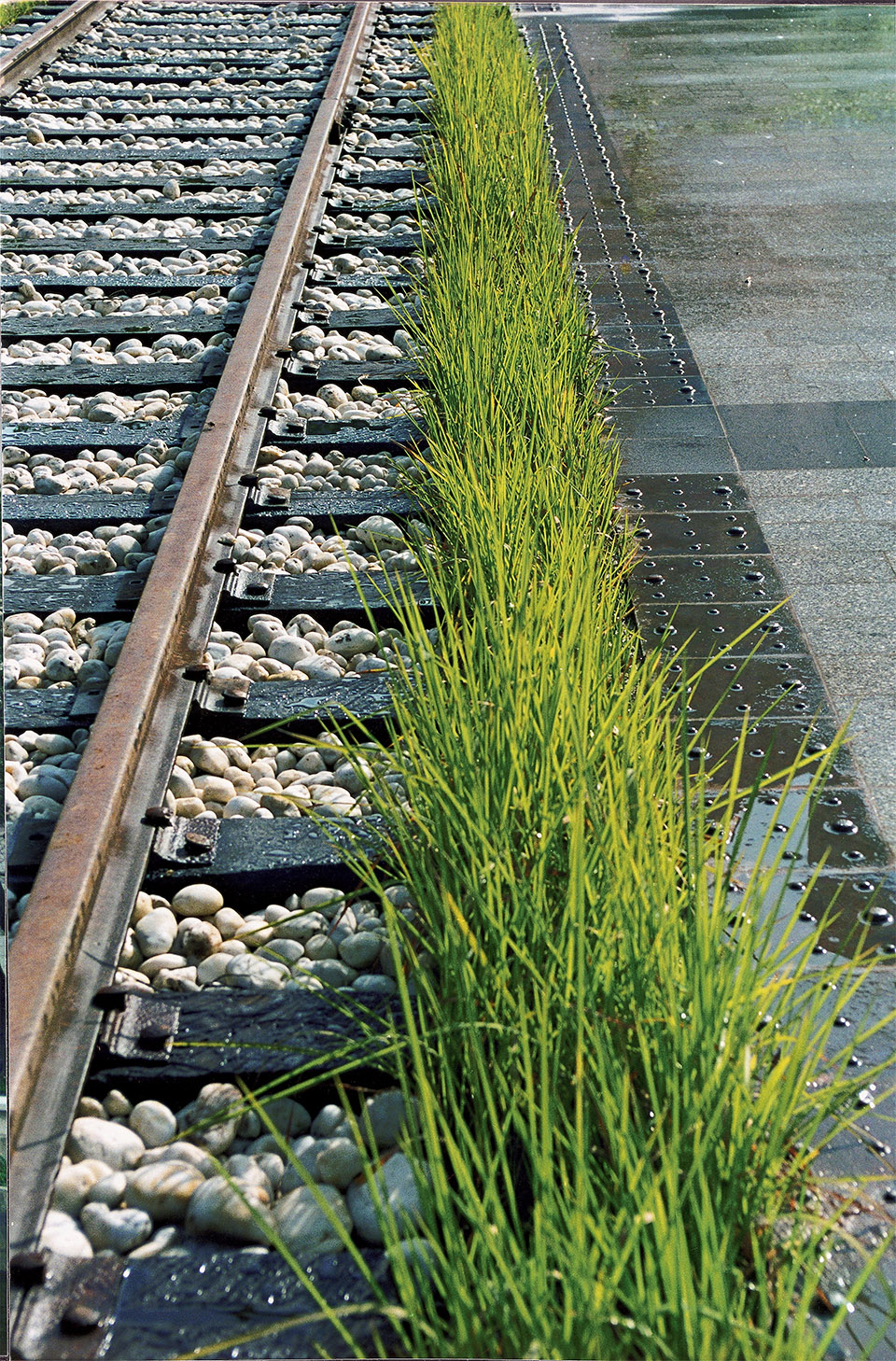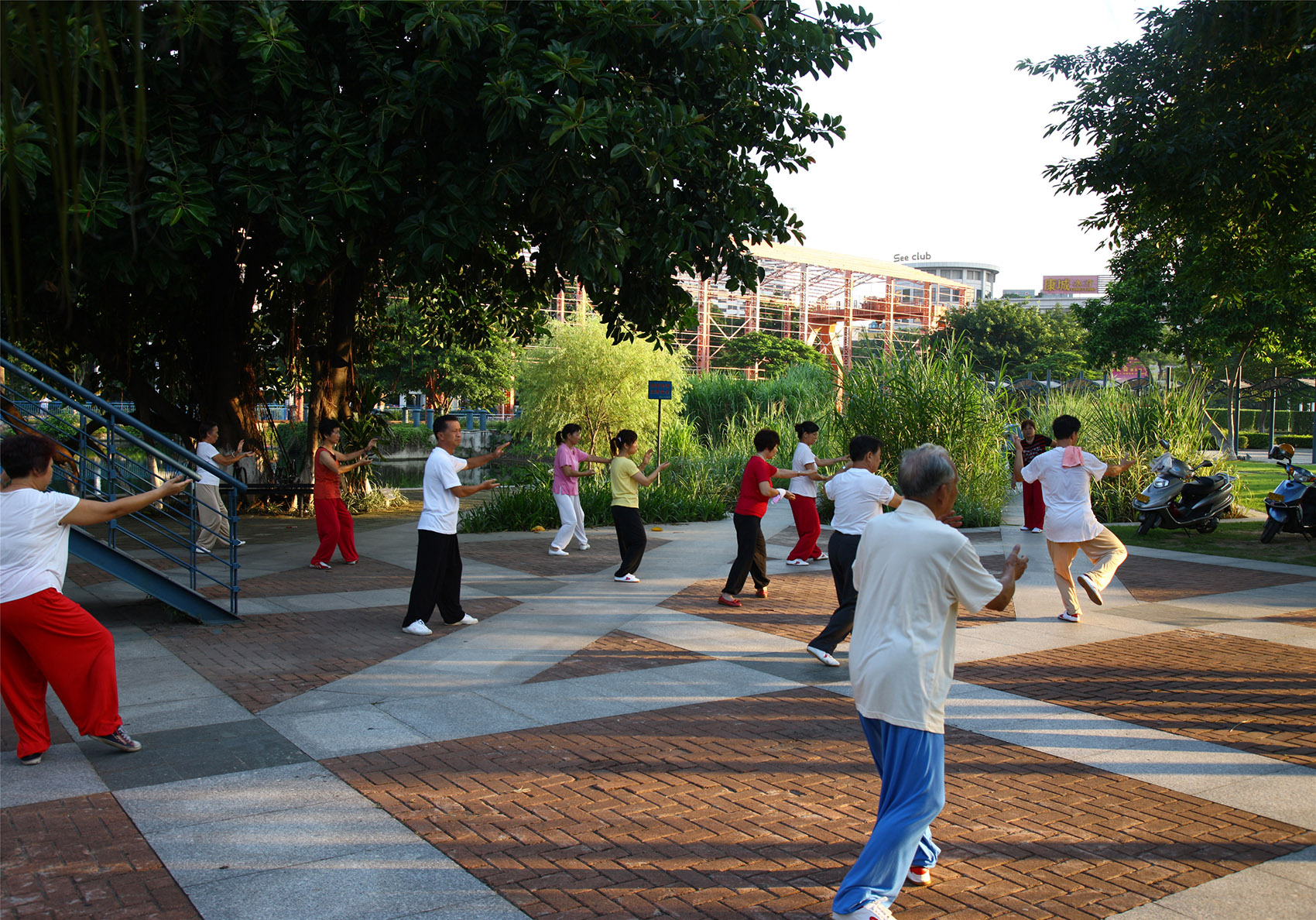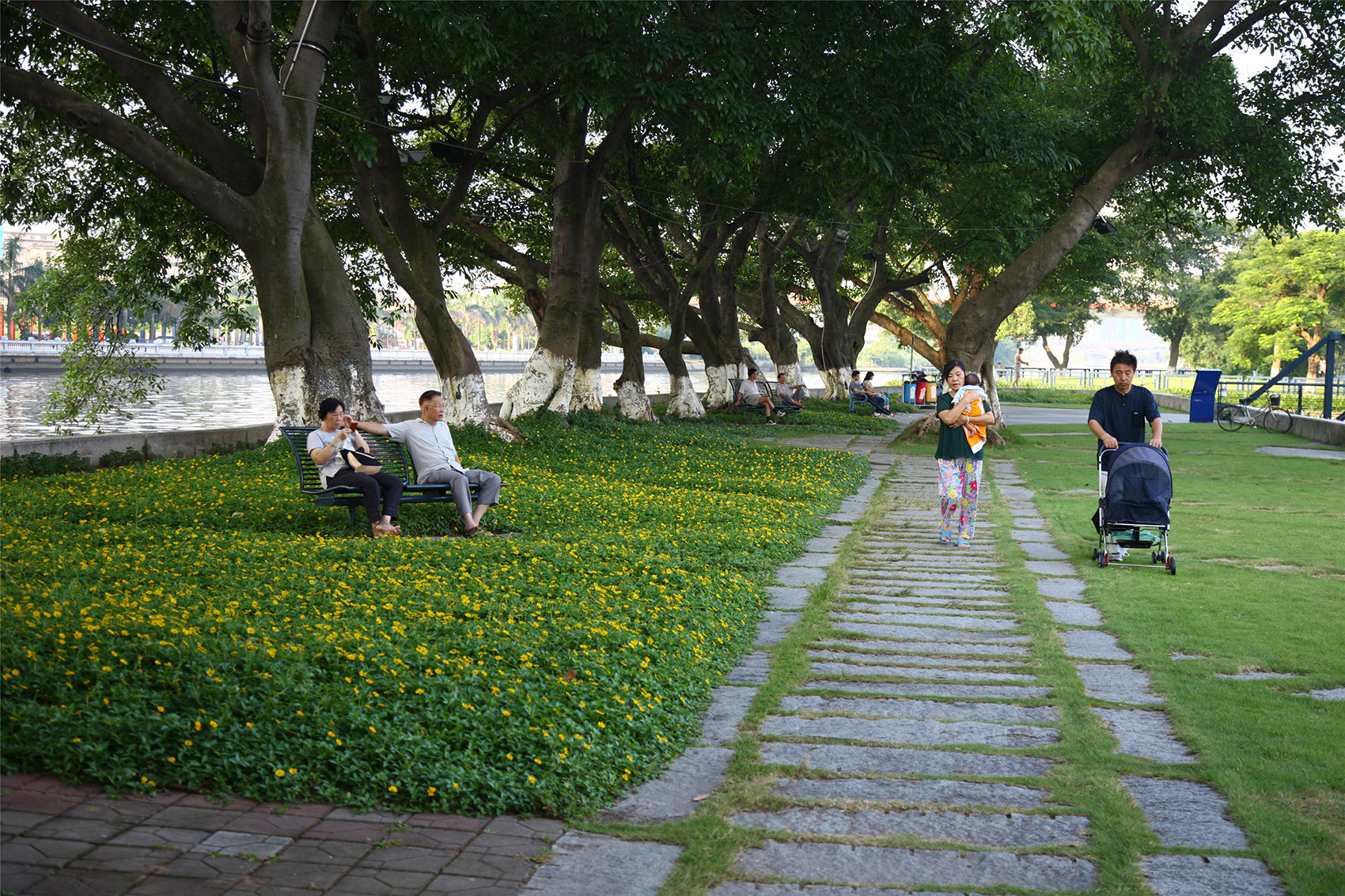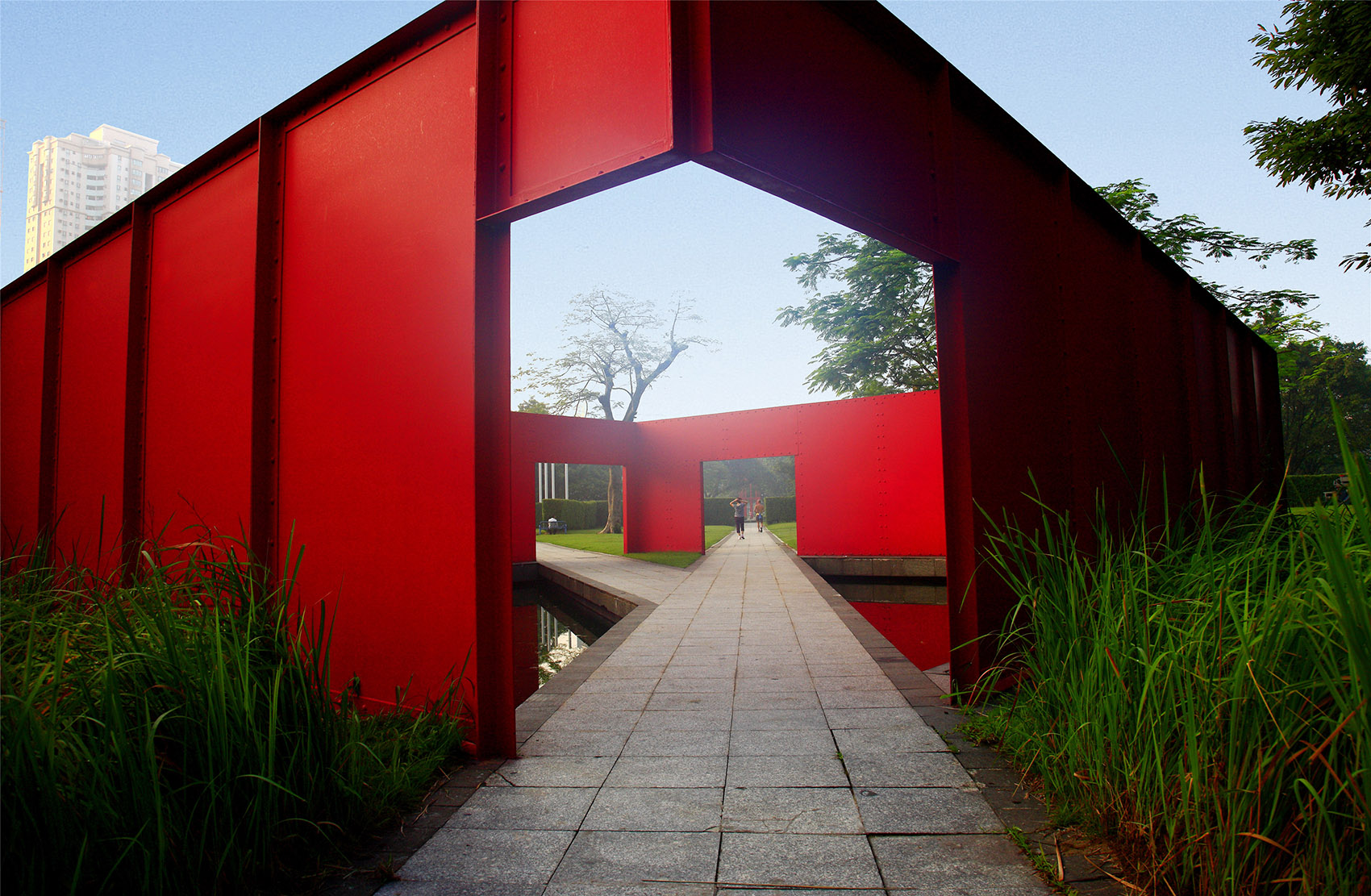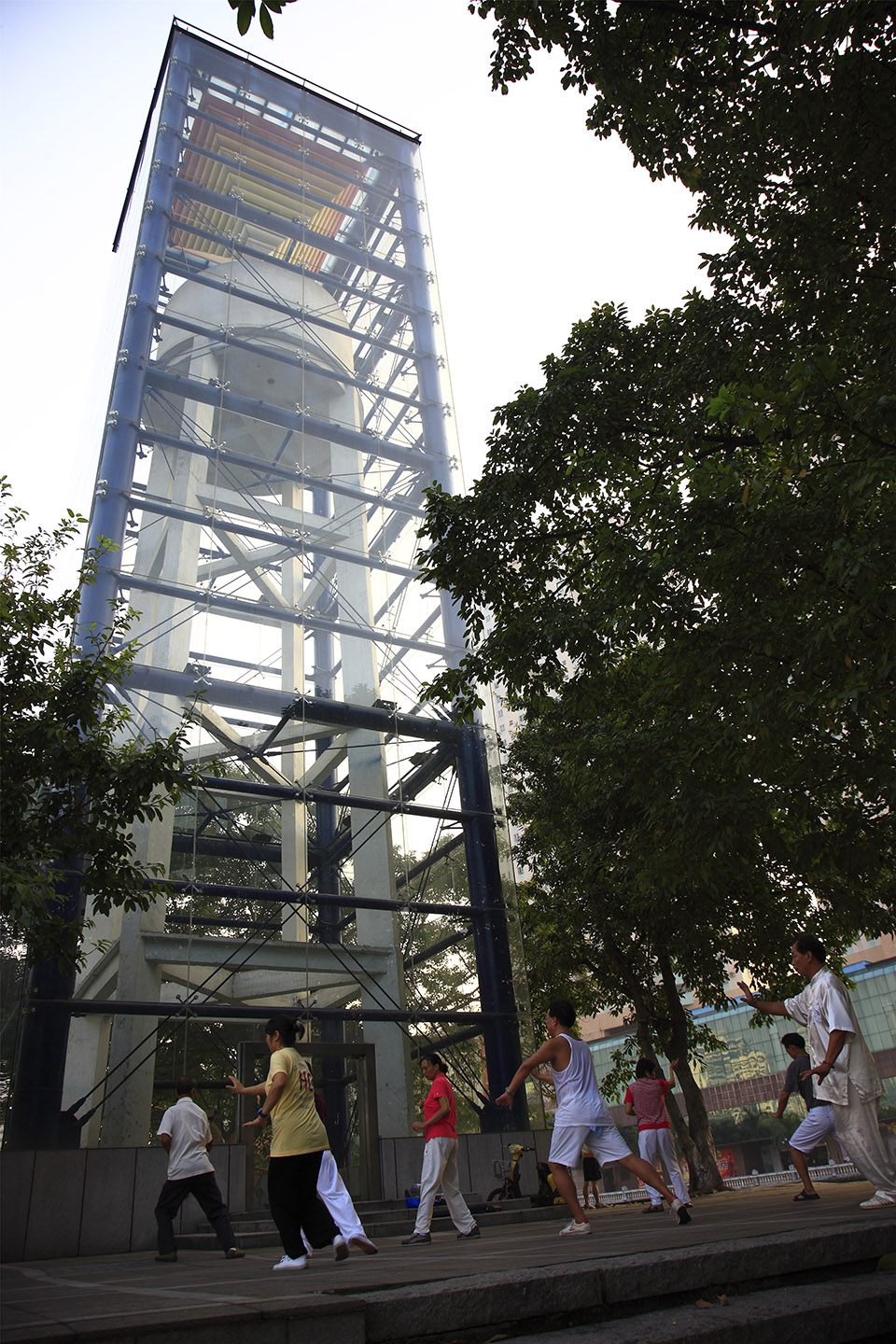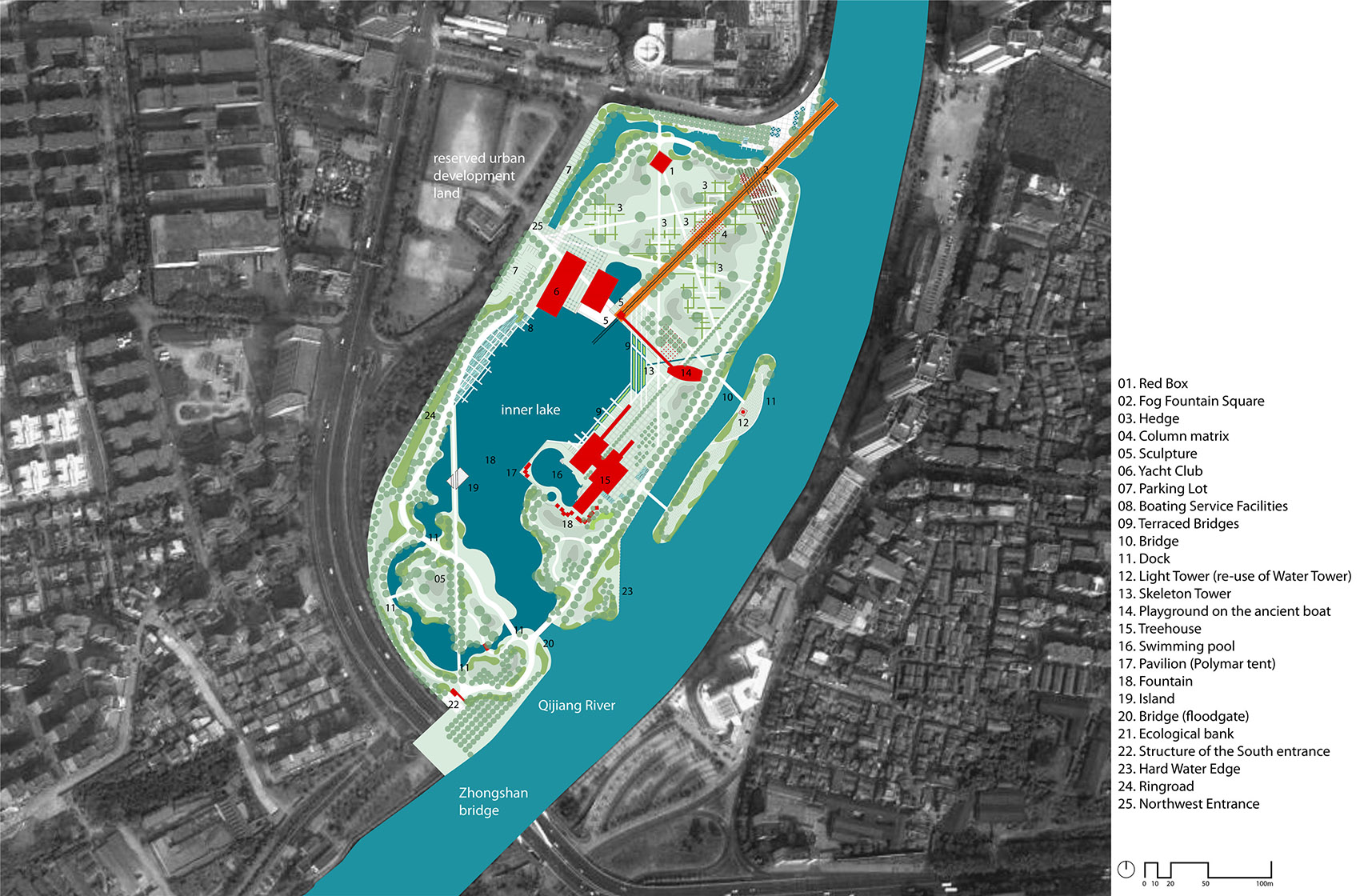在水体景观设计中遇到的一个普遍性问题是如何在水位变化较大的情况下,设计一种亲水性的生态护岸,这需要设计者综合运用植物生态知识,水流动力学知识,以及工程技术,而更重要的是认识人性,特别是人与水,人与生物的微妙关系,以实现一个生态化的、人性化的、实用且美的护岸。本文以广东中山市岐江公园为例,介绍一种栈桥式亲水生态湖岸的设计。建成的效果与设计设想相一致,实现了在水位变化较大的情况下,仍然具有亲近人、生态和美的效果。
This park is environmentally friendly, educational, and full of cultural and historical meanings. It calls people to pay attention to previously neglected culture and history. It is for and about the common people, and asserts an environmental ethic that weeds are beautiful.
▼公园总体鸟瞰图,the overall bird-eye’s view of the park
岐江公园位于广东省中山市区,总面积10.3公顷,园址原为粤中造船厂,设计强调足下的文化与野草之美。其中水面3.6公顷,水面与岐江河相联通,而岐江河又受海潮影响,日水位变化可达1.1米。公园设计的主导思想是充分利用造船厂原有植被,进行城市土地的再利用,建设成一个开放的反映工业化时代文化特色的公共休闲场所。围绕这一主题,形成一系列公园的特色,其中生态性和亲水性是本公园主要特色之一。本文将主要介绍湖岸的生态性及亲水性的设计。
▼总体规划图和重新规划的码头的位置示意图,drawings of the master plan and sections of the reused dock
水位变化下的生态与亲水设计所面临的主要问题有两个:一是湖水水位随岐江水位变化而变化;二是湖底有很深的淤泥,湖岸很不稳定。现状的情况是在高水位时,湖水近岸,岸上植被与水线相接,有良好的视觉效果,而这种高水位却只能维持很短时间,水位下降时,湖边淤泥出露,人也难以亲近。因此,设计师面临的挑战是如何在一个水位多变,地质结构很不稳定的情况下,设计一个植被葱郁的生态化的水陆边界,并使人能恒常地与水亲近,使水 – 生物 – 人得以在一个边缘生态环境中相融共生。同时,这个生态设计必须是美的,只有美的生态,才能唤起使用者的认同。面对以上问题,除了解决工程上的固土护岸问题外,本设计提出了三个基本目标:即亲水、生态和优美。
▼公园局部,设有临水步道,由旧码头改造而成的框架式结构坐落在水面之上,partial view of the park with a waterside path, the framed structures transformed by old docks sit above the water
▼旧码头改造而成的结构体量及其细节,桁架完全暴露在人们的视野中,the structure transformed by the old dock and details of the structure with truss exposed in people’s eyes
▼旧铁轨被重新赋予美学意义,the old rust rails reused as a new aesthetic setting
▼人们在旧铁轨上进行各种活动,the rails are used by the young and the old for practice and wedding scene, and become a new aesthetic setting for the daily use of the common people
针对上述问题与挑战,本案例中尝试了栈桥式亲水湖岸的设计。具体做法有三点: a.梯田式种植台:在最高和最低水位之间的湖底修筑3~4道档土墙,墙体顶部可分别在不同水位时掩没,墙体所围空间回填淤泥,由此形成一系列梯田式水生和湿生种植台,它们在不同时段内完全或部分被水淹没。 b.临水栈桥:在此梯田式种植台上,空挑一系列方格网状临水步行栈桥,它们也随水位的变化而出现高低错叠落的变化,都能接近水面和各种水生、湿生植物和生物。同时,允许水流自由升落,而高挺的水际植物又可遮去挡墙及栈桥的架空部分。人行走其上恰如漂游于水面或植物丛中。 c.水际植物群落:根据水位的变化及水深情况,选择乡土植物形成水生 – 沼生 – 湿生 – 中生植物群落带,所有植物均为野生乡土植物,使岐江公园成为多种乡土水生植物的展示地,让远离自然、久居城市的人们,能有机会欣赏到自然生态和野生植物之美。同时随着水际植物群落的形成,使许多野生动物和昆虫也得以栖居、繁延。所选野生植物包括:水生的荷花,茭白,菖蒲,旱伞草,茨菇等;湿生和中生的包括芦、苇象草,白茅和其他茅草,苦苡等。
▼凌驾在水面之上的栈桥,the new bridge across the existing lake
▼梯田式种植台及步道,不仅可以应对水位的波动,更能让人们体验植物多样性,the ecological and accessible lake shore designed as terraces to meet challenge of fluctuating water levels, and allow rich native biodiversity to take place, at the same time accessible to people
初步的结果表明,试验是卓有成效的,建成不到3个月的栈桥式护岸,基本实现了在湖水变化很大的状态下,仍然保持亲水性和生态性的目标,同时,精心选择的野生植物与花岗岩人工栈桥相结合,产生了脱俗之美感。而且,随着时间的推移,水际群落的不断丰富和成熟,生物多样性将不断提高,生态、亲人和美学效果将更加显著。同时,公园设计对南方雨水充沛及公园水位较高的特点缺乏充分考虑,致使公园局部排水系统不畅,部分绿地水分积聚过多而造成树木生长不良,现场调整后渴望改善;在公园其他地区的植物配置中,一些荫生植物因没能及时得到新载乔木的庇护,影响了观赏观赏效果,随着乔木层郁闭度的提高,乡土生物的多样性将日趋提高。
▼红盒子休闲中心鸟瞰图,bird-eye’s view of the red box
▼红盒子休闲中心外观及其入口,exterior view of the red box and its entrances
▼红盒子休闲中心内部,提供了一种愉快的童年体验,the interior view of the red box that offers the unforgettable bitter and the pleasure childhood experienc
▼因要拓展河道而被铲除的无花果树被移植到一片空地上,同时为人们提供了一个休息空间,an island is created to preserve the old Figs trees that would have been cut for the widening of river for flood control, and detail design is made to create a soft bank and pleasant space for people
▼公园里的休闲空间,the leisure space in the park
▼公园局部夜景,partial night view of the park
▼公园里双塔夜景,the twin towers in the night
At the beginning of the new millennium, China changed dramatically. Urbanization accelerated, state-owned factories went bankrupt, and millions of workers lost their jobs. Together with other old buildings and the vernacular landscape, old factories that occupied central urban space were being demolished for new development, less because their land had high value than because they were considered outmoded and ugly. At the same time, city governments were becoming rich largely because of the preceding years’ open economic policy. China’s “City Beautiful Movement” heated up, mixing European Baroque and traditional Chinese imperial aesthetics. Vernacular landscapes were replaced with landscapes of ornamental horticulture and rockery copied from Chinese classical gardens, along with deliberately odd-shaped buildings and structures. The Cultural Revolution was a sensitive, undiscussed topic. Parks were still gated gardens with entrance fees maintained as places for holidays and special events.
When Kongjian Yu returned to China in 1997, he criticized as wasteful the country’s City Beautiful urban design and ornamental gardening and called for the preservation of vernacular heritage landscapes, including the industrial. Shipyard Park offered the first chance for him to express his values and aesthetics.
Shipyard Park demonstrates Yu’s integration of ecological, social, economic, and cultural considerations: (1) value the ordinary and even the outmoded and consider the socialist industrial heritage of the 1950s, 1960s, and 1970s to be as precious as that of ancient traditional culture; (2) make the park integral to the urban landscape and open to the public free of customary fees for local citizens and tourists; (3) establish a new aesthetic favoring untrimmed and “weedy” native, low-maintenance plants; and (4) design the park to aid in flood control, adapting it to water-level fluctuations.
This park was built on the site of an abandoned, polluted, and dilapidated shipyard (erected in the 1950s and bankrupt by 1999) dotted with old docks, cranes, rails, water towers, and machinery. The design shows how landscape architects can turn a derelict site into an attractive, meaningful, and functional place, and thus contribute to urban renewal.Since the park’s lake connects through the Qijiang River to the sea, water levels fluctuate up to 1.1 meters daily. A network of bridges was constructed at various elevations and integrated with terraced planting beds so that native “weeds” from the alluvial wetland could be grown and visitors could feel a hint of the ocean.
Regulations of the Water Management Bureau required that the river corridor at the east side of the site be expanded to eighty meters from sixty to manage water flow. This meant that more than ten old banyan trees were to be cut down. Turenscape instead dug a parallel ditch twenty meters wide on the other side of the trees, leaving them intact. Since remnant rusty docks and machinery are largely nuisances for local residents, three approaches were taken to artistically and ecologically dramatize the spirit of the site using preservation, modification, and creation of new forms. Native habitats, water, and cultural elements were preserved as found; existing structures, materials, and forms were reused for new functions. Vegetation along the old lake shore was preserved and modified, as were the rails, water towers, and dilapidated machines. New forms included a network of straight paths and green boxes (using figs trees as living walls), and a large red box that dramatizes the character of the site. Functionalism is evident in the network of paths linking key locations and exits, in the reuse of dock structures to provide tea and park services, in the light tower made from a former water tower, and in the paved areas under trees where tai chi can be practiced.
项目地点:广东省中山市 项目类别:海绵城市 项目规模:110 000㎡ 设计时间:2000-7-26 建成时间:2001-7-26 委托方:广东省中山市规划局 所获奖项:2002美国景观设计师协会设计荣誉奖,2009ULI亚太区杰出奖
Location: Zhongshan, Guangdong Province, China Area: 11 hectares (27 acres) Design time: designed June 1999 to May 2001; completed May 2001 Awards: 2009 Global Award for Excellence, Urban Land Institute 2009 Asian Pacific Award for Excellence, Urban Land Institute 2008 Excellence on the Waterfront Award, The Waterfront Center, Washington, D.C. 2004 Chinese National Gold Medal of Fine Arts 2002 Honor Award, American Society of Landscape Architects


